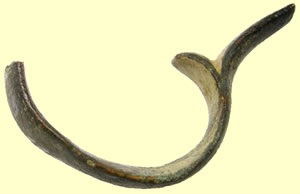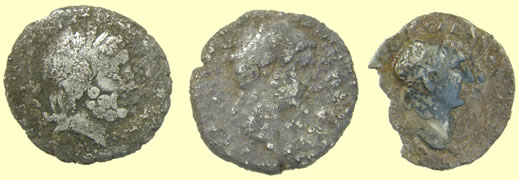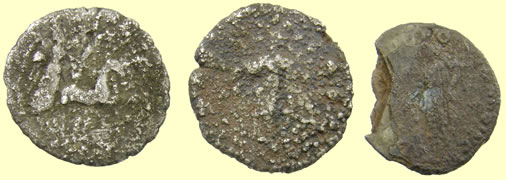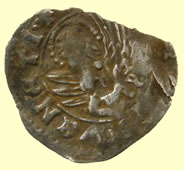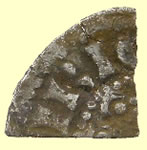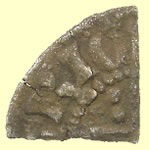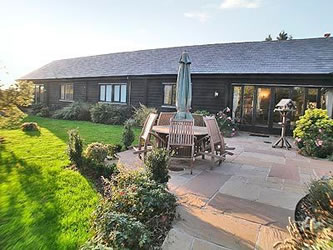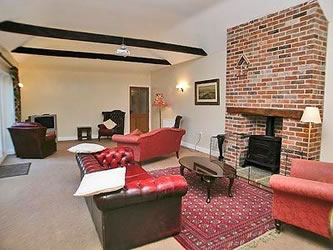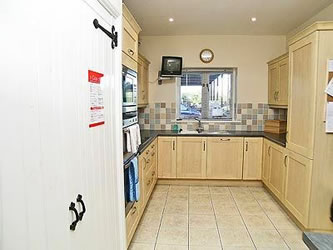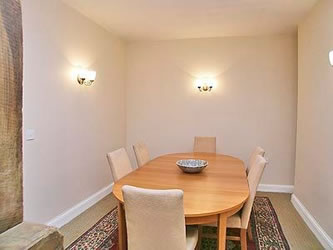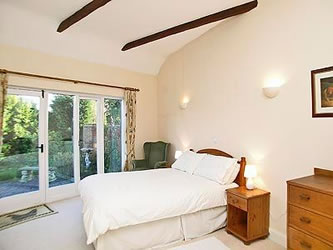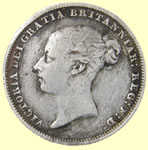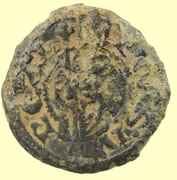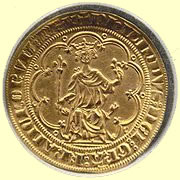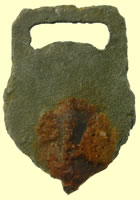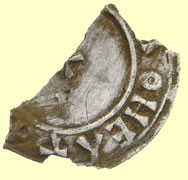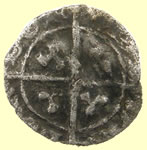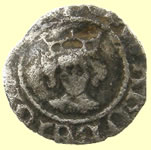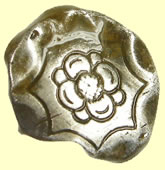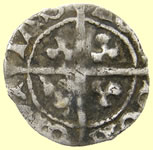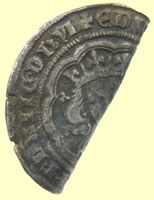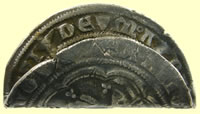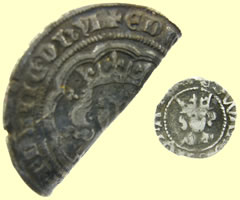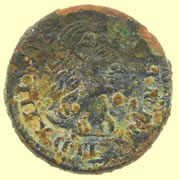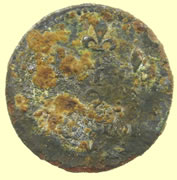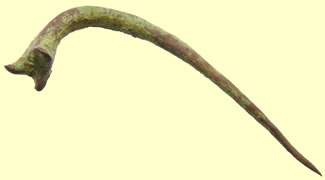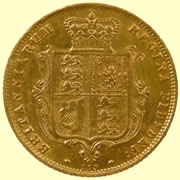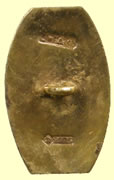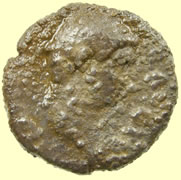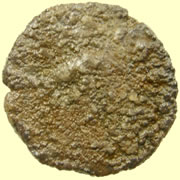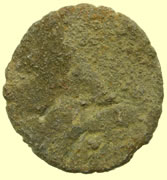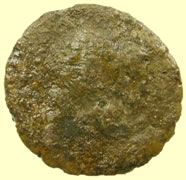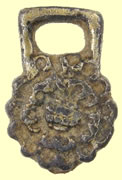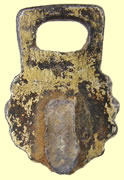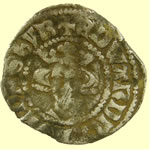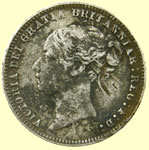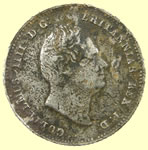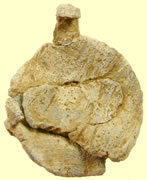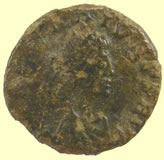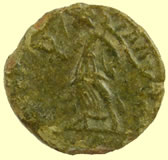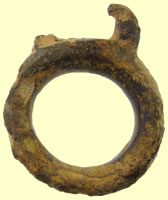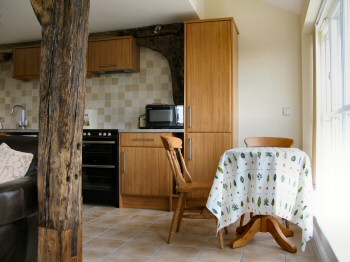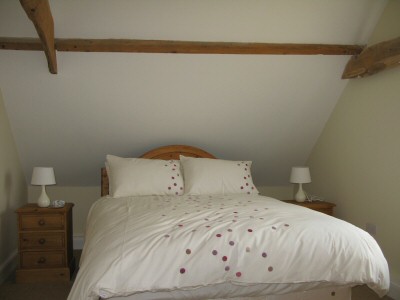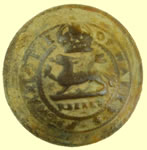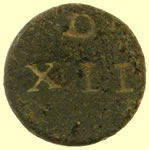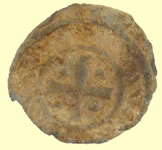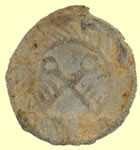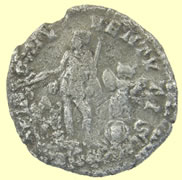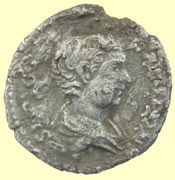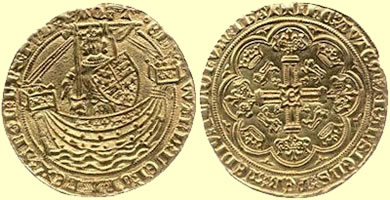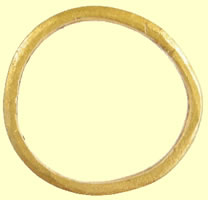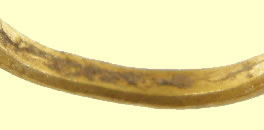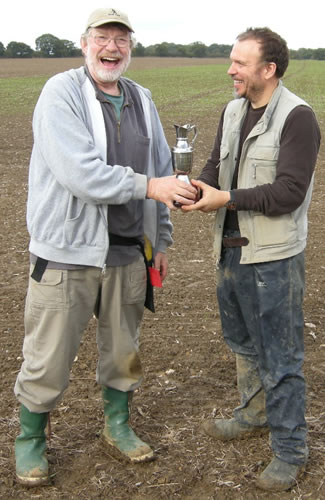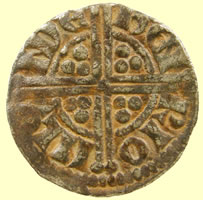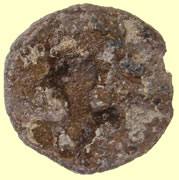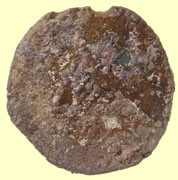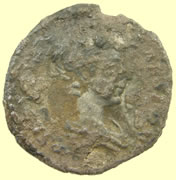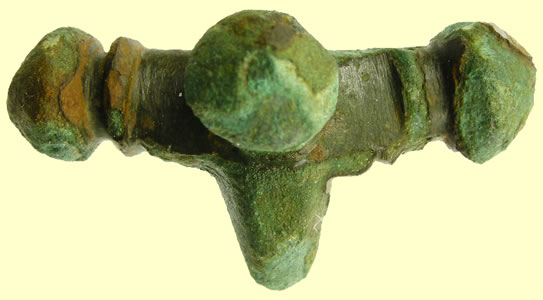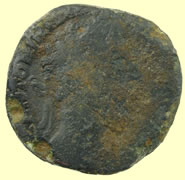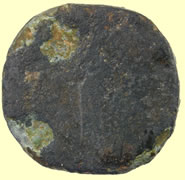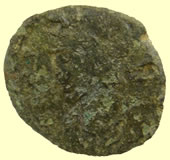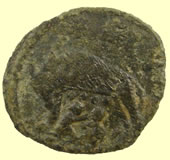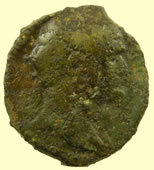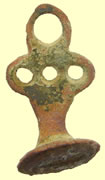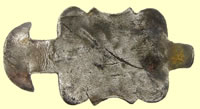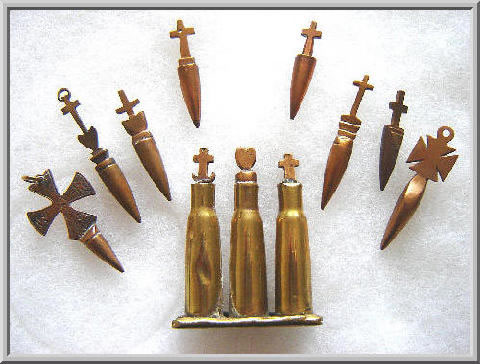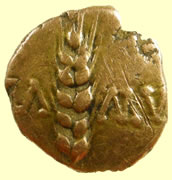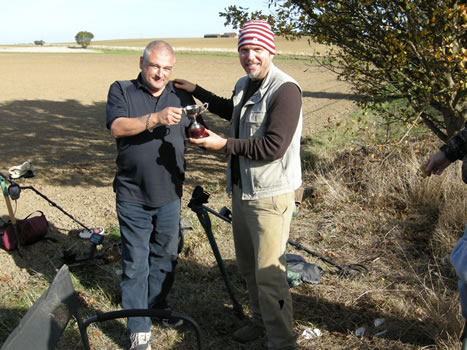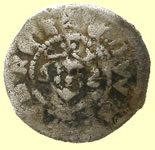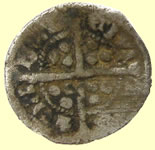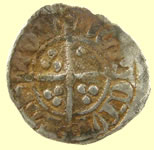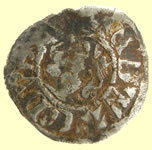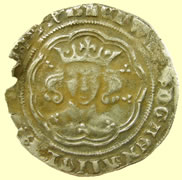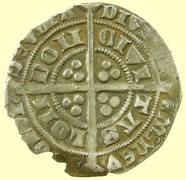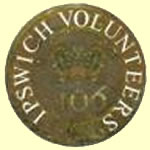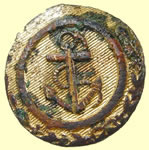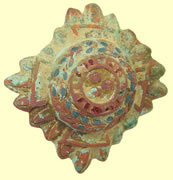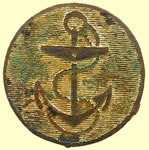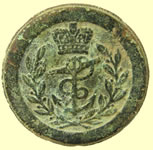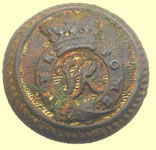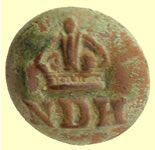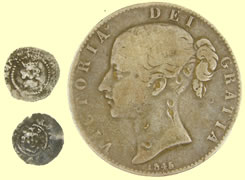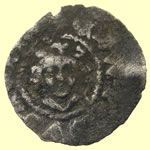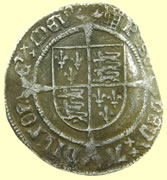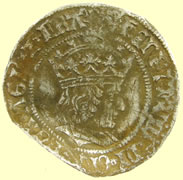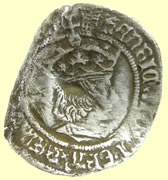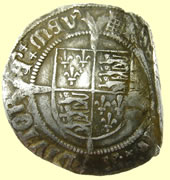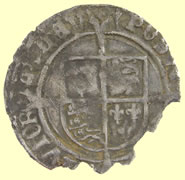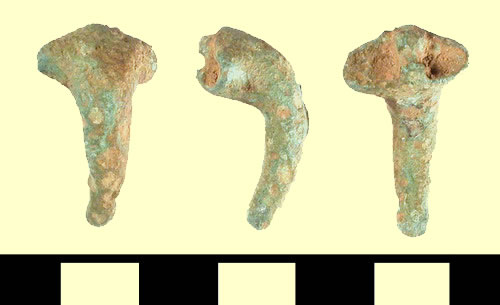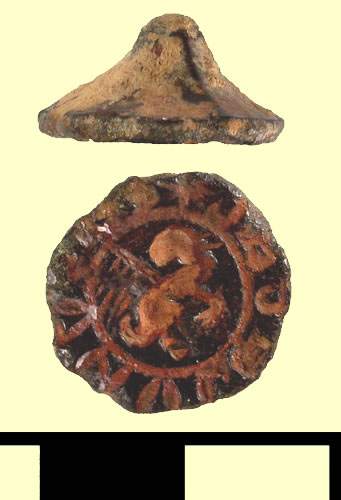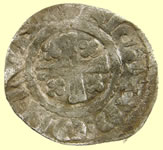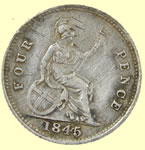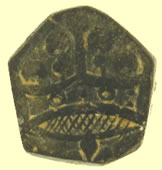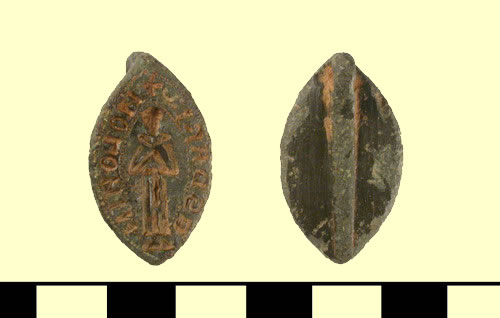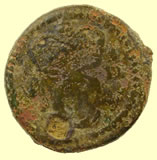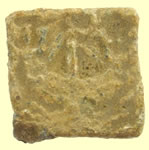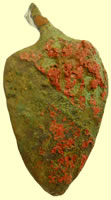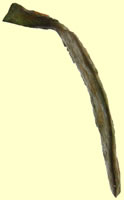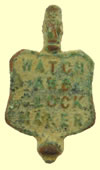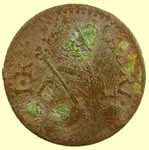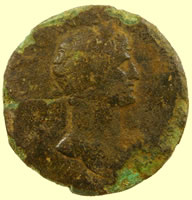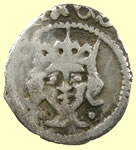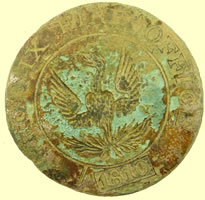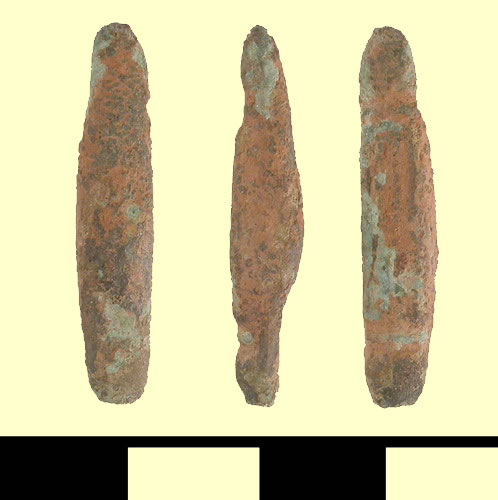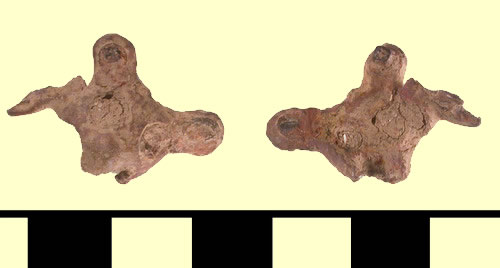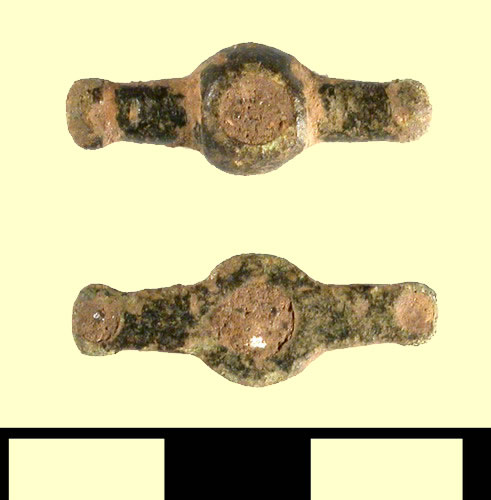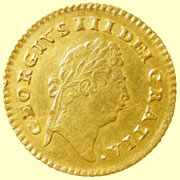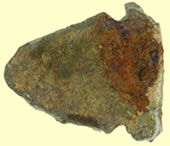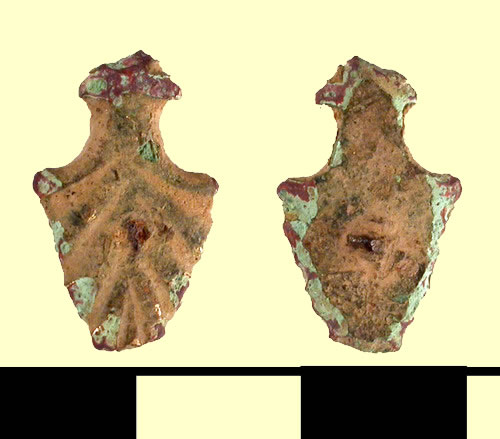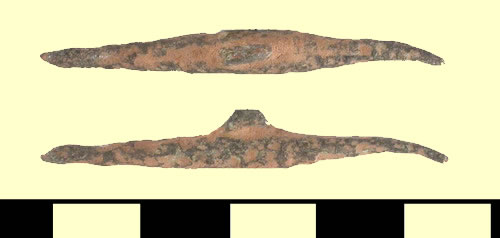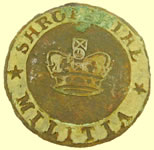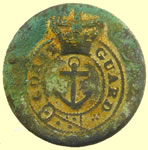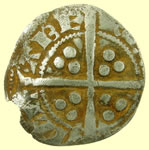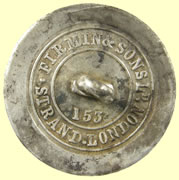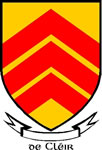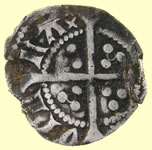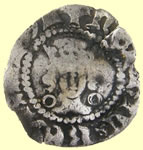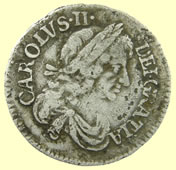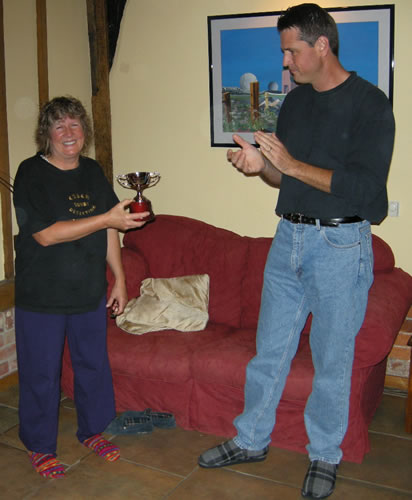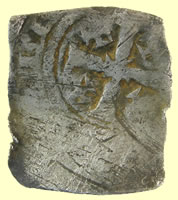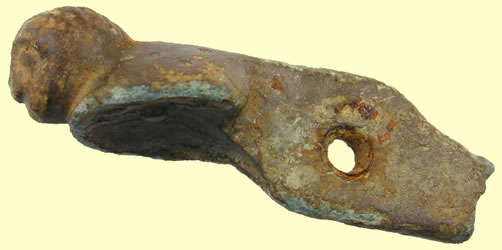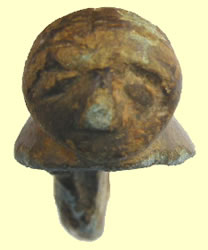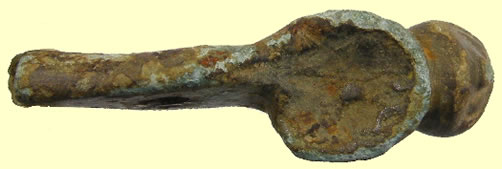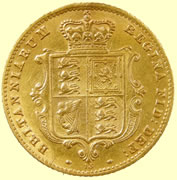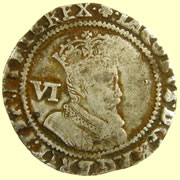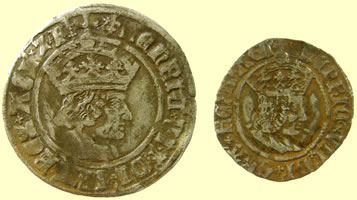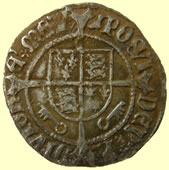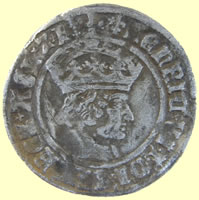

Metal detecting holidays in England with the World's most successful metal detecting club.
Twinned with Midwest Historical Research Society USA
Oct 2009 to Feb 2010 Archived News Page |
26th Jan 2010 Find of the year - more exports - USA hoard
Just two weeks to the kick off and I still have more exports applications to process yet before they arrive so I need to get my skates on. The first team to open the second half of the season are all really experienced Senior members with 2 of our oldest serving members returning, Alaskan Geo and Ark Gary. Geo was the first guy ever to hunt here when we had just 13 fields and now we have over 300 to pick from so he has seen a lot of changes to the club. This is Gary's 26th trip here and he hold's the club record with 13 gold coins, 10 of which are ancient. He is the only member to have found both Celtic, Roman and Saxon gold. Geo found our rarest ever Celtic with the sun and the moon symbols so they know how to sniff out gold. It is interesting that they are both very successful gold nugget hunters over in the USA especially Geo who has literally got pots of the stuff. With a team this strong you know if they walk over it then nothing is missed. 3 of the guys are trialing out the new Barn II accommodation for the club which is just a mile from our new 66 field site. They will be giving us a frank testimonial of how it works out with 3 guys sharing the 2 bed roomed lodge and I will post their report on the site. There are two other lodges free at the new Barn if anyone want to join and join a serious bunch of gold hunters. I have posted more export pictures and find lists to the members forum. Colchester members Fl Don, Mitch, Penn Denis and Christy went on a civil war hunt together in the USA last week and a guy there dug a fantastic little silver hoard in a tin which was captured on video as he opened it . http://www.youtube.com/watch?v=02fZZTtAHbk Updated the forum competition page and the milled copper count now stands at 1974 so far for the half season.
I have updated the 'find of the year' page with my current favourites and fixed the menu bar pointing to the page which had a broken link . At the end of the season every guy that comes here gets to vote for his personal favourite find throughout the season (not his own finds of course) The find with the most votes gets the holder a free weeks full board detecting next season and the engraved Roman jug, not forgetting his name on the role of honor shield ! These are not the definitive list but are a few of my current favourites, members can vote for any finds that are on our site for the season 2009/2010. Billericay Mark's 'excessively' rare Celtic gold coin find is going into a specialist auction at Sprink's in March 2010. Several dealers has shown real interest in acquiring it but this auction will realise the true market value for both the finder and landowner.
|
||||||||||||||||||||||||||||||||||||||||||||||||||||||||||
24th Jan 2010 More site updates and exports Updated the individual find pages below with more finds from the first half of the season. We have now found sufficient coins of William IIII to create it's own page William IIII milled silver coins. Just posted another 3 export pouches with find lists and pictures on the members forum. I have updated the forum competition page and the milled copper count now stands at 1947
|
||||||||||||||||||||||||||||||||||||||||||||||||||||||||||
22nd Jan 2010 Joe's Sapphire ring offer- more exports
Disclaimed treasures returned to finders I have posted more exports to the members forum. I have had a couple of e-mails from guys asking why their treasure find has been missed off their applications. Please note, no treasure or hoards you found will appear on your export license as they are currently with the British Museum being evaluated. Only if they are subsequently disclaimed can they be returned to you which can take several months. In that case I will apply for a 2nd export license for that item. I have updated the forum competition page and the milled copper count now stands at 1899. I still have a few more export pouches to do yet so I reckon the half season total will be around 2000. It all depends how the new 66 field site for Feb 2010 pans out but we are probably looking at between 3500 and 4000 milled copper coins for the season total. I have updated this site's menu system to include the new forum link and prepared a new Feb 2010 finds page ready for the kick off on the 10th. A few more bonus finds out of the pouches below.
I dropped another bunch of finds today to the museum for recording and ID'ing today including one of the medieval stap ends below. We have found several so far this season and it is not known what the suspension hole was used for but I suspect is was for a pendant of some description. There appears to be several different varieties and fixing methods for the leather strap end. I have been searching the PAS database as I was told there are already several recorded on there.
Medieval Stap type and 'prong' type where two metal sheets were riveted through to secure the leather
Ill Joe's medieval sapphire gold ring find was declared treasure at the coroners inquest in Sept 2009. The ring has been through the valuation committee stage in Dec and both the farmer and finder have been offered a reward. However Joe sent me the letter from the valuation committee and they appear to comparing it's type and value to another ring that is not really a suitable example . They have compared Joe's ring to fig (407) and not the one on the right (402) which is almost an exact match but larger. I spoke to the Treasure registrar today at the British Museum and they are going to review the case. That is the real strength of the English treasure process that you have the right to appeal any offer made and present evidence to the contrary. All previous finds made together with their pictures, ID's and values are available to view on line to find a comparison. http://www.culture.gov.uk/reference_library/publications/5620.aspx
'I received my letter from the museum and a valuation . They are basing the valuation on figure 407 in the treasure report 2005-2006. Looking that ring up I see it as 2005 T214 from Bexhill, East Sussex. Their letter incorrectly identifies figure 407 as 2005
T274 from Bexhill, East Sussex. Also, the description of figure 407 states, "the stone is deep blue, heavily scratched, and may be a sapphire or glass." This ring also does not look at all like mine. The ring you located, figure 402, treasure2005 T206 looks identical to mine, which they also agree, but state it is larger. Any suggestions,' Joe
Joe's Black Sapphire Medieval gold ring 21.93mmdia,2.51g Treasure Report: 2008 T580 A Medieval finger-ring with a simple wire hoop and a symmetrical hexagonal bezel set with a sapphire.
|
||||||||||||||||||||||||||||||||||||||||||||||||||||||||||
16th Jan 2010 Finally back up and working - more exports and updates - forum update Just 25 days to the start of the 2nd half of the season
Great to get my main PC back up and working properly now. Meanwhile I have continued posting more finds lists and exports to the members forum using an old standby laptop. I have not transferred the bonus do dad pics out of the pouches or sent out Export Word doc's yet from this laptop. I will try and get it done today so you get a copy sent to you. The new members forum is amazing and members have started uploading their England finds to their own photo albums. These pictures are held on our own SQL server linked to the forum so they are searchable by any key words. Chicago Ron has also started blogging on the forum with great detecting tips and will be doing a whole series of helpful blogs. Ron has only one slot free on the last week of his first 3 week self catering booking at the New Barn II accommodation in March to hit the new 66 field site if you want to join his team. There are still some free lodges in Feb if you fancy being the first guys ever on this new site and just a mile from the site. Remember you have your own car and can wander aimlessly, for as many hours as you like, around all of the 66 fields until your arm drops off. I still have to get more laminated maps made up of the new site as it is such a monster and we can get totally lost. One pass around this new site equates to a 16 mile walk so the new pocket sized maps are essential. Make sure you read up on all the history info and study the maps on the members forum prior to your trip.
I dropped a huge batch of bent hammered gold and silver coins off to our goldsmith for fixing yesterday. I am especially excited to see how the two medieval hammered silver gold coins we found in the first half of the season turn out. Neither of them are torn or missing any chunks. I will be posting the before and after pics once they come back to the coin straightening page I have updated the forum competition page and the milled copper count now stands at 1760. Here are a few bonus do dads out of the export pouches I did yesterday on my repaired PC.
|
||||||||||||||||||||||||||||||||||||||||||||||||||||||||||
11th Jan 2010 Main PC failure continues - Some updates The bad weather has delayed the replacement parts for my main PC so I still have limited access to files and photo's. I am still continuing with export applications though by now using my standby laptop. I have posted a load more find lists and pictures to the members new forum. http://www.colchestertreasurehunting.co.uk/detecting. The old forum is now closed for posting, if you are a member and do not have a log on yet drop me a mail. This is closed members forum. I have updated the forum competition page and the milled copper count now stands at 1628. Hopefully my new PC kit will arrive today so I am back in full swing.
|
||||||||||||||||||||||||||||||||||||||||||||||||||||||||||
8th Jan 2010 PC failure Unable to post any more exports and updates due to main PC failure. I am waiting for replacements parts today.
|
||||||||||||||||||||||||||||||||||||||||||||||||||||||||||
5th Jan 2010 More exports and updates - members forum The new members forum is taking shape nicely and I have transferred over half the membership over so far. I have set up an auto RSS feed from our foundintheground.com finds database to populate a finds forum when updates are made. Clever widget. The site has a lot of extra features where we can post articles like the one below of the 'newbies' first hunt when he found a found a £1 million treasure, great story. http://www.colchestertreasurehunting.co.uk/detecting
£1 million pound treasure dug on first outing Uploaded more export find sheets and photo's to both the members forum. I have posted more missed finds from the pouches below including some really nice buttons. The guys found a great new house site this season that produced some early numbered regimental buttons and more of the early unrecorded 5th dragoon guard buttons. That is our 16th find of these superb buttons that are unrecorded in any publication. They must have been stationed here in Colchester which has been a garrison town since the Roman times and still is. Updated the Forum competition page. The count has now hit 1500 milled copper coins which will probably rise to over 2000 for the half season as I process more export pouches.
|
||||||||||||||||||||||||||||||||||||||||||||||||||||||||||
2nd Jan 2010 Happy new year to all - £18,000 offer - forum update - new land update The Treasure valuation committee met in Dec to decide on a value for our 7 finds declared Treasure by the Essex coroner in Sept. Ten Brad has received an initial offer of £18,000 for his gold statue find but the other 6 guys have yet to get an offer. Both the landowner and finder can appeal the decision and present proof that the valuation should be higher or accept the offer and then receive a cheque in the mail for half each. The English treasure act is the fairest system in the world where the finder is rewarded with the fair market value as set by a panel of experts and dealers.
Treasure Report: 2008 T581
A medieval figure of John the Baptist. The saint is
shown not in his usual attribute of a camel skin, but in the robes of
a prophet. He gestures with his right hand to a salver, which he holds
in his left. This was originally designed to carry a lamb, signifying
the Lamb of God. A scroll issues from the Saint’s left hand and
is inscribed with the words The figure stands on a small plinth with a finished base. It is designed to be seen in the round and on its back there is a loop for attachment to an object. It would probably have been entirely enamelled, but no traces of enamel survive on the figure. The figure is gold and dates from the late fifteenth or early sixteenth century. Dimensions: height 33 mm, width 11 mm, depth 10 mm. Consequently, in terms of age and as the object contains a minimum of 10% precious metal it qualifies as Treasure under the stipulations of the Treasure Act 1996. The new members forum is running well and I am sending out new log on and passwords to all the members. http://www.colchestertreasurehunting.co.uk/detecting I have been playing with publishing articles and adding info to the various sections. If will be a couple of weeks until we close down the old forum. I have posted more export find lists and photo's to both forums and will double up postings for the next couple of weeks. Updated the Forum competition page. The count is now 1434 milled copper coins
New 66 field site for Feb 2010 update The scale of this new site is mind blowing so we are approaching the searching of this site is a different manner than we normally do. I sent the landowner a new master map of his land which I had highlighted into 5 coloured parcels and he has replied approving the proposed sectors. Each parcel's fields are numbered on a master map and the 5 sectors are named. A team can pick any one of the 5 parcels for a mornings hunt and then can either stay where they are lunchtime or move to a different parcel in the afternoon. Each sector is approximately 13 fields adjoining each other. I will inform the landowner the night before which parcel we intend searching so that game keepers/workers know where we will be as a lot of shooting takes place on his land. The landowner and I have set a password so that if you are challenged by a gamekeeper while searching the password ensures you are a valid dectectorist on his land. The sheer scale of this land also means we must approach the plotting of finds made in a very structured manner. Each guy will get a laminated map to plot finds as they go as there is no way to remember where on a 4 mile sq plot you found them. I will transfer that information each day to a huge master finds map I have had produced. Just one pass around this plot is 8 miles so it will take years to build up a picture and the spread of finds on the master map. Each member can view the master finds map when they arrive. The first team are our pathfinders as the map is blank !!!
|
||||||||||||||||||||||||||||||||||||||||||||||||||||||||||
31st Dec 2009 More ID's More finds - Curator's report - New members forum We have a new professional members forum so we get rid of that pesky pop up adds and virus attacks. The new forum is CMS based so it has lots of clever widgets and additional features. Check out the site below . All members will receive a new log on and password sent to them by mail. I just received the British Museums curator's report on Mark's medieval gold ring find, very interesting report. http://www.colchestertreasurehunting.co.uk/detecting/ A few more bonus do dads out of the export pouches I cleaned up included a really nice 18thC silver button that was a black lump. There were a couple of Conder tokens that I managed to get an ID on. Conder tokens are probably
the most popular of the English token series. They were widely collected
200 years ago, and are still avidly collected today. During the 1790's
there was a shortage of small change in Britain until private merchants
started having their own large halfpennies and some pennies struck.
Thousands of different designs were issued and the social, economic,
and political lives of the people during the 1780-1800 period are mirrored
on these coins. These coins are called "Conder" tokens, after James
Conder, an early author on the series, though many mistakenly call them
"Condor" tokens. The fact that some feature different birds adds to
the confusion. Some Conder tokens found their way into circulation in
the U.S. and Canada. Posted more export find lists and pictures to the members forum. Updated the Forum competition page. The count is now 1314 milled copper coins
Treasure Report: 2009 T579
A Medieval finger-ring of D-shaped section with inscriptions on the external and internal surface. The inscription on the outside of the hoop has seen much wear and is largely illegible. It appears to consist of the following letters: SE NA R SE?L The inscription on the inside of the ring is crisp and legible and spells PENSETZ This is a variation on the French word ‘pensez’, meaning ‘think’ (of me). This single word is often deployed on rings with romantic inscriptions. The ring’s proportions suggest that it may have been worn on the small finger of a slender woman or by a child. The ring is gold and dates from the fifteenth century. Dimensions: internal diameter 18 mm Consequently, in terms of age and as the object contains a minimum of 10% precious metal it qualifies as Treasure under the stipulations of the Treasure Act 1996. J P Robinson
|
||||||||||||||||||||||||||||||||||||||||||||||||||||||||||
28th Dec 2009 More new land research posted - updates
More updates to individual find page with finds from the 1st half of the season. There were some brilliant numbered regiment buttons finds from corps we have not found before.
I have reset the countdown clocks to the 2nd half of the season which starts early again this year on the 10th Feb. It is amazing how quick time flies and the 2nd half of the season starts in just over a month now. More export find lists and photo's have been up loaded to the members forum. The guys have ben doing a lot more great research on our new 66 field site for the 2nd half of the season. 2400 acres converts to 3.75 miles x 3.75 miles so there is a monster amount of land to try and cover. Can Rod just posted brilliant info on a huge Saxon/Viking battle site that could have taken place somewhere on the land. Check out the forum for the link to the history of the battle web site. Mass Linda has posted a map of all the Roman roads, dykes, ring ditches etc so check those out also. Remember we can only search this land out of animal hunting season from Feb to April so if you can get away after the new year for a hunt then you can stay at the New Barn accommodation just up the road from the site. The pound took another dive against the US and Canadian dollars over the last few days making the hunts even cheaper again. Updated the Forum competition page. The count is now 1177 milled copper coins Special thanks to Hendrik from Belgium for sending me a picture and ID'ing one of our unknown jetton finds below. I have updated the Jetton page
|
||||||||||||||||||||||||||||||||||||||||||||||||||||||||||
25th Dec 2009 Happy Christmas to all - more exports and updates - Treasure case numbers issued
More finds uploaded to latest finds Nov page Happy Christmas to everyone out there, members and readers alike. Special thanks to all our farmers, experts and the museum staff for their sterling work during another great season. I get to take a day off from processing finds to get pairs of socks and eat loads of turkey. I posted more export find lists and pictures onto the members forum and there were some great bonus do dads in the pouches like the early bronze weaving shuttle ? There was another new 17thC token guy for our set in Can John's pouch and I have updated the 17thC token page. I have great buttons to play with yet. Updated the Forum competition page. The count is now 1084 milled copper coins. As I process a guys pouch I update the page.
Unrecorded Navy button (left) in poor shape - Normal 3 anchor types (examples right ) do not have the rope on the two small anchors and there are 3 letters below main anchor - sent off to our button expert Tim for his views.
I just an e-mail from the treasure registrar at the British museum with the case numbers issued for our latest reported items. You should be getting letters from them shortly.
Treasure Case No: 2009 T502 Treasure Case No: 2009 T520 Treasure Case No: 2009 T521 Treasure Case No: 2009 T522 Treasure Case No: 2009 T615 Treasure Case No: 2009 T616
|
||||||||||||||||||||||||||||||||||||||||||||||||||||||||||
23rd Dec 2009 Roman silver cooked - Another Roman hoard coin - More updates and exports Updated the Forum competition page. The count so far is now over 1000 milled copper coins. I have finished 'cooking' the Roman silver find by Ohio Jerry and managed to get part of the legend showing. I sent it off to Mark for his final views as this is one of the rarest Roman silvers ever dug here. By his comments It appears to be on par with the very rare Emperor Galba dug several years ago by Ark Gary.
Very rare 69 AD Otho Roman silver coin- as dug to 'cooked'
One of your two silver coins here is VERY interesting.
I'm 95% sure it's Otho - one of the three short-lived successors of
Nero in 69 AD. When Nero committed suicide, he had been such a
bad, totally self-involved ruler that there wasn't any semblance
of an orderly administration to turn-over the reigns of government peacefully
to a successor. Three major contestants arose and succeeded
each other in short order - Galba, Otho and Vitellius - before
Vespasian (who was off in Palestine biding his time, laying seige to
Jerusalem and sacking the Temple) on seeing that they'd all succeeded
in wiping one another out, returned to Rome as the victorious general
and founded the Flavian dynasty (which built the Colosseum over the
remains of Nero's Domus Aurea, etc.
Otho, himself, was around for only about 3 months
(15 Jan - 17 April, 69) total, so his coins (he struck no Imperial AE,
incidentally, only gold & silver) are among the rarest in the "normal"
series of Roman emperors. You might recall me getting fairly excited
when one of your diggers turned up a Galba (Otho's immediate predecessor,
and not quitte so rare) a couple years ago.
I can't tell from the reverse just what it was when
it was minted. It appears to be a standing deity or personification,
but there's just not enough detail to have a good idea who was intended.
Very interesting, however - one sees so few Othos in general.
I have just completed Canadian Ed's export pouch and man did he dig a bucket load of finds including a whole bunch I did not photo while the hunts were underway. I have posted them to the Nov finds page It appears he was the first guy to find a coin out of the Roman bronze hoard as he had an exact match of the hoard coins in his pouch. I have reported it to Colchester museum for inclusion into the 'pot' which Mass Bruce, Mike and Scott found a week later. As you can see from Mass Bruce's example below they are identical. Mark Lehman sent us his views when the first 7 were found below
Can Ed's coin 350-353 AD Magnentius & Decentius appears to be the first coin found from the Roman bronze hoard discovered later by Mass, Mike,Scott and Bruce. This was in Ed's export pouch and has been reported to Colchester museum
Mass Bruce's example 350-353 AD Magnentius & Decentius - hoard is currently at the British museum Unless I am mistaken, all 7 of these belong to the
brother team of Magnentius & Decentius - a fairly short-lived (350-353
AD) Augustus/Caesar pair of the sort promoted to Augustus, ad-hoc, by their legions. This was a very common story during the
chaos-years of the later 3rd century, but happened far less
often in the 4th. Magnentius had been a top general
of Constans' - his army proclaimed him Augustus and since Constans did
him the favor of being captured and executed conveniently quickly
- within a few months - Magnentius was duly recognized as Augustus in
most of the Western provinces in 350. The next year he elevated
his little brother Decentius to be his colleague Caesar.
Constantius II was not pleased by the Western upstarts
and within 2 years had defeated them in a couple of significant
battles. Realizing the jig was up, they both committed suicide
in 353.
Although these reverse types are known for other
rulers (for whom they are pretty rare), they are especially associated
with Magnentius & Decentius, both of whom were always portrayed
"bare headed" - no laurels or diadems, etc. - and both of whom sported
distinctive "mullett" hairdos like you see on the clearest specimens
here. Since I believe the obverse legend on that nice one of Bruce's
ends in "AVG", I'd say it's most likely Magnentius. Any on
which the obverse legend ends (around 5:00) in CAES, CAESAR, NOB
C, or NC can safely be assumed to be Decentius.
The type with the 2 Victories resting shield
inscribed: VOT / V / MVLT / X on a cippus (or just holding it between
them) woul have a legend like: VICTORIAE DD NN AVG ET CAES - and
was common for both of them. The large Chi-Rho Christogram reverse
was used on both the centenionalis and short-lived double-centenionalis
denominations - it's not really scarce, but is sought-after making it
a bit more expensive for those wanting to buy one. This is a common
factor in ancient coins, those with some sort of "religious" reference
are always found desirable by folks who have no other interest in ancient
coins, thereby driving up the prices (like the so-called "Tribute Penny"
denarius of Tiberius - of which your diggers have found several - which
is the most common silver coin of the early 1st century, but sells for
3-4 times as much as any other).
This pair struck only in the Western mints: Amiens,
Trier, Lyon, Arles, Aquilea, Rome and Siscia
You have the Chi-Rho reverse 90º counter-clockwise
out of alignment, by the way. in the left and right interstices of the
Chi are "A" and "W" (Alpha/Omega). You can see these letters pretty
clearly on this specimen although the "P"-shaped top of the Rho seems
to have taken too much damage to be visible.
Some examples from my collection:
Magnentius: Chi-Rho double-centenionalis: http://www.stoa.org/gallery/album167/26_Magnentius_SAL_AMB
typical 2 Victories:
2 Victories from a British MD find:
a couple less-common reverses:
Decentius:
Mark I have updated more individual finds pages below with our finds from the first half of the season below.
|
||||||||||||||||||||||||||||||||||||||||||||||||||||||||||
21st Dec 2009 More exports, finds & updates Updated the individual pages below with finds from the first half of the season. There is now a new section on the members forum dedicated to guys research on the new 66 fields site for the 2nd half of the season. Check out the fascinating info on the castle and abandoned church.
As I process the export pouches and post them on the members forum I am updating the copper count on the Forum competition page. The count so far is just under a 1000 milled copper coins. There have been a couple of real nice bonus do dads out of the export pouches, missed while the hunts are underway, including a real nice medieval seal matrix and another treasure.
Canadian Bill has been cleaning up his medieval seal matrix find and sent me a new wax impression of it. What a cracking job, the legend and bust of Christ is now mint.
Medieval seal matrix - ESS-26B3A7
|
||||||||||||||||||||||||||||||||||||||||||||||||||||||||||
17th Dec 2009 More uploads and updates I have uploaded a load more export finds list and pictures to the members forum. I am processing the guys finds and export applications who are coming back for their 2nd trip this season first, so they have a chance to take them home with them on their next trip if they are back approved in time. I have some really interesting items to take to the museum for further analysis like Cal Jim's 2 medieval seal matrix. There is an excellent site showing a whole series of 13thC personal lead seals with ID's - click here to view I have updated more individual find pages below with our finds from the first half the season, you can also check out more on our foundintheground database and use the search tool. I have updated the forum competition page with the latest total.
|
||||||||||||||||||||||||||||||||||||||||||||||||||||||||||
13th Dec 2009 Page updates Updated the individual pages below with this seasons finds
|
||||||||||||||||||||||||||||||||||||||||||||||||||||||||||
12th Dec 2009 More Romans ID'd - returned treasures - new kit
I dropped off more finds for recording out of the export pouches to the museum yesterday and several disclaimed treasures were ready for collection. They included Can Dan's hand made gold ring that he found next to an 850 BC axe head. In almost all cases our plain gold ring finds are disclaimed by the British museum and returned to the finder as there is no way to prove their date without an expensive gold test that they will not undertake on a ring of little significance. For a gold or silver item to be officially declared treasure they have to able to prove that they are over 300 years old, if not they are disclaimed and returned to the finder. I have uploaded more export finds lists and pictures to the members forum.
I am getting ready for the 2nd half of the season on the new land and took the huge AO master map of the site into Staples who have an amazing set up for copying, reducing and laminating. I got a full set made of each size from AO down to A4 so we can choose the best size for guys to use out in the field. I have split the site up into 5 colour coded manageable chunks and numbered all the fields to allow easier finds recording. There are 66 fields in total on the new site so each chunk is approximately 13 fields. Guys are in full flight on the members forum researching the site and I will add key fields like the 1066 AD medieval castle location and fair sites onto the maps. This new site is so massive that I will setting out our large pop up tent each day in case the weather turns rough. I have already bought all the extra kit so that guys have a portable tent heater and a cooker to be able to make hot drinks and warm up during breaks.
Mark Lehman has been ID'ing more of our Roman coin finds out of the export pouches below.
108 AD Tajan
Yes, the chipped silver coin is a denarius of Trajan,
without a doubt. He was Augustus from 98-117 AD. and the Empire
realized its greatest physical size during his reign. His successor,
Hadrian, (wisely, as it turned out) started right off by trimming-back
the less defensible and more troublesome parts Trajan had conquered
and added to the Empire - he notably gave Parthia back to the Parthians
- and as you're familiar from your local history, did what he could
to tighten up and defend the borders in the extremities of what
remained in the Empire.
Making a few fairly safe assumptions here -
first and foremost that what is missing from the reverse legend would
have read: "COS V P P S" (PQR OPTIMO PRINC being what's visible), it
would date to the general time frame of 103-112 AD - Trajan was
Consul for the 5th time in 103 and for the 6th in 112 - this coin is
typical for the "COS V etc, etc. series of reverse legends. If,
as I'm guessing, the figure on the reverse is Aequitas holding scales
& cornucopiae, it would date specifically to 108.
Mark
13.55g, 30.30mm
I'd have to guess that the coin is a dupondius (or
somewhat oversize As) of an Antonine woman - one of the Faustinas,
or possibly Crispina. These ladies were Antoninus Pius' wife -
Faustina I - died in 141 and was the subject of a huge posthumous
coinage series. Marcus Aurelius wife - Faustina II, daughter of
Faustina I - was married to him throughout Antoninus Pius'
reign, then died in 175 and so had a huge lifetime series under the
2 emperors, and was also the subject of a posthumous series,
although not nearly on the scale of her mother's commemorative coinage.
Commodus' wife, Crispina, was arguably the most
attractive woman (by modern standards) ever portrayed on Roman coins,
but since she was implicated in one of the many plots the paranoid emperor
"detected", so subsequently put to death fairly early in his
reign, her lifetime coinage is somewhat scarce and she has no posthumous
coinage.
There really isn't enough detail left on either
side to be sure which of this trio she might be, but my best guess would
be a lifetime issue of Faustina II. The reverse is also too
vague - with none of the details of attributes visible - making
it impossible to be sure who it is, but is more than likely one
of the many allegorical personifications of abstract Roman virtues.
Mark
2.29g, 19.42mm
The coin appears to be an "AE2" (but chipped down to
a much smaller remnant, the size of an "AE3") of Gratian, Valentinian
II or Theodosius I - the reverse ty pe is "REPARATIO REIPVB" and shows
the emperor standing left raising a female allegorical figure of
"The Republic" kneeling on his left.
These date to around 378-383 AD. There isn't
enough legend on the obverse of yours - and the portraiture had
become too cartoonish by this time - to tell which of the three Valentinian
dynasts it might be.
Here's a photo of what I think it looked like, originally,
on a specimen of Theodosius I:
|
||||||||||||||||||||||||||||||||||||||||||||||||||||||||||
9th Dec 2009 Our Rarest Roman silver find ID'd - new land contracts signed
I have a meeting this week with the museum to drop the last couple of treasures and finds for recording on the national database. Hopefully there will several of our disclaimed treasures ready for pick up icluding Chicago Ron's gold pendant. Updated our Hoard & Treasure page with latest info More export find lists and pictures posted to the members forum. Updated the forum comp page with the latest copper total free forum competition page
60 + new fields The contracts were signed yesterday for our new 2400 site from Feb and I now have the large scale OS map of the fields. I spent several hours driving around and taking pictures of the fields and have posted 58 pictures I took on the members forum. It is a real mixed bag of fields, small ones, large ones, monster ones, woods, ponds, steams. Crops are mostly wheat with the odd rape seed. A rough count puts the field numbers at 60 +. This site has never been detected before and is right next to the most important area of Roman/Celtic Colchester. The numbers of fields I viewed is mind blowing but we have the GPR pictures of the known Roman village to use as a starting point. Continuing research by the club members has shown two abandoned medieval villages, abondoned medieval church, site of a castle and huge numbers of Roman dykes, rivers, roads etc. Because of the sheer physical size of the site I will probably break it down into 4 more manageable chunks of 600 acres each so we have some idea of what we are covering. In a morning a team can pick one of the 600 acres plots and in the afternoon decide either to stay where they are or pick another 600 acre plot. I will be getting the huge supplied poster sized field map laminated which we can use as a master plotter for finds made. A single site this large will require years of hot spotting especially as we can only search it out of animal hunting season between Feb to April. The first team on the site will be the early 'mud and slush' hunt on the 10th Feb. The New Barn II we are now using is just a mile from the site and can be used extensively as a base to search this new site. This new Barn is split into 3 seperate lodges so parties from singles to 7 can be accommodated. Drop me a mail if you can get away after Christmas and be the first guys ever on this new plot. I might even extend the season into late April if there is sufficient interest. The two final Roman silvers I have been 'cooking' for the the last month had sufficient detail showing through now so I sent them to Mark Lehman our Roman coin expert for his views. The report that just back from him is amazing as one of them is an Otho, the rarest Roman silver coin ever found here. What a great find
As dug to latest 'cooked' 69AD Otho silver Roman coin I still have this coin in the 'cooker' to see I can get more obverse detail One of your two silver coins here is VERY interesting.
I'm 95% sure it's Otho - one of the three short-lived successors of
Nero in 69 AD. When Nero committed suicide, he had been such a
bad, totally self-involved ruler that there wasn't any semblance
of an orderly administration to turn-over the reigns of government peacefully
to a successor. Three major contestants arose and succeeded
each other in short order - Galba, Otho and Vitellius - before
Vespasian (who was off in Palestine biding his time, laying seige to
Jerusalem and sacking the Temple) on seeing that they'd all succeeded
in wiping one another out, returned to Rome as the victorious general
and founded the Flavian dynasty (which built the Colosseum over the
remains of Nero's Domus Aurea, etc.
Otho, himself, was around for only about 3 months
(15 Jan - 17 April, 69) total, so his coins (he struck no Imperial AE,
incidentally, only gold & silver) are among the rarest in the "normal"
series of Roman emperors. You might recall me getting fairly excited
when one of your diggers turned up a Galba (Otho's immediate predecessor,
and not quitte so rare) a couple years ago.
I can't tell from the reverse just what it was when
it was minted. It appears to be a standing deity or personification,
but there's just not enough detail to have a good idea who was intended.
Very interesting, however - one sees so few Othos in general.
The other silver coin I have seen before and believe
is Trajan - the reverse legend is very typical for Trajan. That
big flake of silver which probably came from an adjacent coin breaking-down laminated to
the lower left makes it uncertain, and the dating titles are chipped
off the flan, but I believe, at least, that it's Aequitas, holding a
set of scales and cornucopiae. You didn't send me a copy of the
obverse photo this time, but it's OK, I tend to remembe it from before
and thought it was Trajan then, too.
Curious Roman bronze with female bust and castle on obverse ? 28.43mm, 14.72g Sent to Mark for ID
Your big copper coin has posed a bit of a problem.
Although it looks very like a crenellated castle-tower on the reverse,
there was never any such reverse - or anything even particularly close
- on a Roman Sestertius (and this is almost certainly a sestertius
by the size and weight) or any other roman coin except the silver Argentii
of the Tetrarchy. It might be a female on the obverse, or it might
be one of the more effeminate-looking younger men in the Severan dynasty.
It could as easily be a young Caracalla (who became Caesar at the age
of 4) or his brother Geta, or even Elagabalus, as it could be either
an Antonine or Severan woman. I'll need to do a bit more research
in hopes of finding some sort of a reverse which might have a section
which might look like a tower-top - probably in a different rotation
from its intended orientation.
Mark
|
||||||||||||||||||||||||||||||||||||||||||||||||||||||||||
6th Dec 2009 Cooking Roman silvers and exports- 1300 BC Ring update
On display at the BM Ron, who was on the last barn hunt of the season, went off and visited the British Museum after his tour and snapped this picture of a gold armlet on display there that is an exact match of the ring Oregon Ed found below earlier in the season. Thanks to Ron for sending it to me as it answers a question we all had as to why the ring was so small for a finger. I wonder if the rest of the armlet is still out there ? Ed's ring is currently with the experts at the BM and it will be interesting to read the final curators report.
Monster find -Ed's Circa 1300BC Bronze age gold open backed triple banded gold ring 3.48g, 13.73mm dia x 6.74mm H Reported to Colchester museum as treasure
Just posted more export finds lists and photo's onto the members forum. Chicago Ron had a curious Roman bronze coin in his pouch with an unusual obverse that I have sent off to Mark Lehman for his views. I have just about finished cooking the last 2 Roman silvers the Ohio boys found several weeks ago with mixed results.The 1st Roman silver is in very poor shape and is laminating badly from it's as dug condition. The crust on this coin was an 1/8 inch thick and there is sufficient detail showing through to send it again to Mark Lehman for his views. The 2nd Roman is a lot earlier and thicker and I have sent that off to him as well for his views. If you are 'cooking' Roman silvers yourself it can take months to complete the process as 'horn' silver growth is like concrete.
600 AD Saxon silver sceat 1.20g, 12.12mm
Updated the Saxon page with the latest finds Updated the forum comp page with the latest copper total free forum competition page
As dug
Cooking
Almost cooked now- 17.34mm ,1.86g
As dug - latest 'cooking' pictures Still 'cooking the 117AD Hadrian silver Roman 3.22g, 18.81mm
Curious Roman bronze with female bust and castle on obverse ? 28.43mm, 14.72g Sent to Mark for ID
|
||||||||||||||||||||||||||||||||||||||||||||||||||||||||||
5th Dec 2009 Paperwork and export time - Saxon gold hoard Watch the latest video on the amazing gold treasures found
Amateur’s treasure trove valued at $5.5 millionLargest Anglo-Saxon gold haul ever was found in farmer's field
Finally got the 'painful' yearly paperwork done and can now get on with the export preparations. All guys export finds lists and photo's are posted on the members forum in full. This is such a value add exercise as every piece of metal found here during the first half of the season is closely re examined again, photographed and listed as part of the export applications into a Word document. There are always nice do dads missed while the hunts are in full swing. Last season I found a crusty Roman silver in with a guy's 'copper coin' bag that 'cooked up' to be our oldest ever coin find, 136BC silver Roman. As I do the pouches I will update the free forum competition page with the total of 'milled copper coin' finds so far. I have completed a couple of the export applications and cleaned up what looked like a crusty plain lead disc out of Atlanta Mike's pouch and discovered the impression of a 13thC personal lead seal matrix, great find. I have attached the Word document page so you can see what kind of finds a guy makes during his trip. Every find over 50 years old must be photographed and itemised to form part of the export application. That includes pottery and any item man made.
Circa 1260 AD lead personal seal , 4 have been found attached to pasture rights. The design is typical of mid 13thC non heraldic seals Yesterday I went and met the new 'Barn
II' owner again to and they have been really busy getting things
ready for us for our Feb trip. The big Barn next door to the lodges
has been completely cleared out for storing our gear, places to hang
cloths, change our boots on a muddy day and they even put tables and
chairs in there for us to sit down. You can arrive at the Barn II on
your first day as early as you like and change here to go out detecting
and not wait for the rooms to be ready, great idea. Oregon Ed sent me a really nice testimonial of his trip when he got that stonking 1300 BC gold ring, posted it to the testimonial page
Atlanta Mike - 'coin hunter' of the year 2008/9
Atlanta Mike's 2009 complete export pouch - click on pictures to enlarge Mike is one of our top Senior members and last year won the clubs 'coin hunter' of the year award and again this season has set another impressive total to beat with 93 coins dug in a week. The pictures below show what a seriously skilled and dedicated detectorist can unearth. The export process is straight forward. This Word document is attached to an export application form and fired off to export duty. Important pieces are take to the local FLO at the museum for recording with find spots on the national PAS database. Those unknown or specific items, like the Roman votive offering or bust finial , are further examined by experts and can be sent to the British museum specialists to determine their exact ID and date. Export duty advisors looking at the application can request further details on any items prior to granting an export license. This ensures that no nationally important pieces or treasures are missed.
I am still 'cooking' the last two Roman silver coins found and the detail is coming through very slowly especially on the obverse.
As dug - latest 'cooking' pictures Still 'cooking the 117AD Hadrian silver Roman
|
||||||||||||||||||||||||||||||||||||||||||||||||||||||||||
29th Nov 2009 Huge hoard in Sweden - final finds uploaded - half season summation A huge medieval hoard of 9000 silver coins has been found in Sweden and it really highlights how fortunate we are in England to have a robust Treasure Act in place to reward the finder with the true market value. The British system is the envy of the world as it actively encourages finders to report all treasures and hoards found. Dedicated local FLO's (Finds liaison officers) are in place to specifically handle these type of finds with defined processes and laws in place to ensure fair play to finders and landowners.
9000 Medieval Silver coins found in Sweden
Here is the english translation by Mass Bruce Just uploaded the last of the guys finds from last week to the latest finds page Nov 2009 finds page. Those 'Barn' guys had a great hunt and found the first Braintree 17thC trade farthing type to add to our collection. These are such a great relic as they are mid 17thC Circa 1650 and have the guys name, profession and where he was from on them generally. I have updated the 17thC token page
I have finished 'cooking' the 82 BC Roman silver find by Ohio Tom and it turned out superbly. The obverse legend is different from the example pictures Mark Lehman sent me so I have sent him the now clearer obverse pictures for his comments.
The other two Roman silver finds are 'cooking' along slowly.
As dug and nearly cooked - 3.40g, 18.81mm
Finished 'cooking' the 82BC silver Roman - Mark's example from his collection on right
End of the half season summation - thanks to all
That's it, we are closed now for detecting until early Feb when the 2nd half of the season kicks off again . It has been another bumper start to the season and our best ever gold find rate with 20 pieces being found. They range from our earliest ever gold find, 1300 BC gold ring, to a beautiful George IV full sovereign coin. The last Celtic gold coin found was off a new field, poughed for the first time, it is probably the rarest example ever found here and there could be more out there. To find two English medieval hammered gold coin finds in a whole season would be staggeringly rare, the guys got 2 in the first half which is without precedence. What is even more astonishing is even with 300 fields now for the guys to pick from these finds came from all over the place, old land, new land and what we had previously considered 'crap' land.
That is the beauty of the way our club runs the hunts, guys picking their own sites to search each day from the maps and research. The site where the Edward hammered gold and Cunobelin Celtic were found is an 800 acre site we had for several years , in the middle of nowhere, where you could not have dragged me by my finger nails to search it. Canadian Rod discovered an old house site on it by research and Ron's team were looking for hammered silver around it when the gold coins were discovered.
Other brand new site for this season that initially looked like it 'sucked' went on to produce a wealth of finds including two of the rarest silver coins you can find, Saxon penny's. Then another new site produced a 3rd Saxon penny making 3 for the half season. You have to bear in mind how rare these are to find, in 6 years of searching we have only ever found 4 so this is a staggering result. This effectively is how the season went on week by week and I was surprised as much as the guys that found them.
A new 800 acre site from last season that produced the medieval gold statue, just a few hammered silver coins but mostly Georgian finds suddenly with more effort from the members produced two 850BC axe heads, the 1300 BC gold ring and then our first ever Roman bronze coin hoard. The field the hoard came from is enormous and we could not have got them all yet. It will takes years of the plough turning that spot over to see the total number buried. We are hoping that there are some silver Roman coins buried within this hoard.
All of these finds are due to the high degree of skill and dedication by the members who are out there for long hours in all weathers. The level of tiny hammered silver finds like, cut qtr's, half pennies and farthings is at an all time high proving that the guys are seriously on their game. I would like to thank all the members for continuing to make these hunts such a great success with great humour even when out there getting skunked and rained on. Special thanks to all the museum staff that handle all our treasures and finds and especially to the landowners that allow our to search their properties. The 2nd half of the season will be very exciting as we will be spending a huge amount of our resource on the two new sites we have been asked to search. The largest one is 2400 acres, around 60 fields and could be our best ever site. Members have been researching the site and 'goggle earthing' it to discover a huge known Roman village at it's centre, dykes, Roman roads, two abandoned medieval villages, disused churches etc. Unfortunately we only have a small window of opportunity to search this site from Feb to April (out of hunting season) so we will only get to scratch the surface of this site. So with all the new land coming and if we can manage to find the hot spots, this could end up as out best ever season on record.
|
||||||||||||||||||||||||||||||||||||||||||||||||||||||||||
26th Nov 2009 Curators report - more finds uploaded - Sal's vid I have knocked up quick video of Sal's 2009 hunt but there are just too many clips to include them all and too many finds to add to it. Even reducing it to a small streaming video size it is still 36Meg. Click here to view. I have taken the remaining pics of the finds from last weeks hunt and uploaded a few more to the latest finds page Nov 2009 finds page. Hopefully I can complete all the uploads tomorrow. I just received the curator's report below from the British museum on one of our previous finds reported as treasure, very interesting 15thC silver knight figure. Updated the hoard and treasure page with the latest update from the British museum.
1594-6 Elizabeth hammered silver half groat - Wool pack mintmark
Treasure Report: 2009/T218
A small Medieval figure of a knight, missing his arms and the bottom part of his legs. The sinuous pose suggests that the figure is meant to represent St George spearing the dragon. The dragon ought to have been positioned beneath his feet, but this part of the composition is missing. In this respect and in terms of its dimensions, the figure resembles mass produced pilgrim souvenirs generated by the cult of St George at Windsor Castle. What distinguishes this figure is that it is cast in the round unlike pilgrim badges of the same period. On the reverse are the remains of a loop, used either for stitching on to a garment (most likely) or for suspension. The figure is silver and dates from the fifteenth century. Dimensions: length 18 mm, width 9 mm. J P Robinson
I did more work today on the 82 BC Roman republican silver find with a tooth pick as the 'cooking' is really softening up the crust. The detail is really showing though now so back in the 'cooker' for a final time possibly. Mark Lehman sent me a picture of a similar example from his collection
As dug and nearly cooked - 3.40g, 18.81mm
AR Denarius Serratus, 82 B.C.
|
||||||||||||||||||||||||||||||||||||||||||||||||||||||||||
25th Nov 2009 Paperwork time - more uploads - 82 BC Roman silver 'cooked'
Louisiana Sal took hundreds of video clips with his hat cam that he left me during his visit that I am making into a 'movie' at the moment - will upload tomorrow
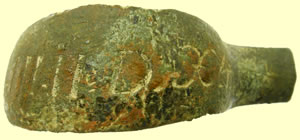
Neat relic 18thC musket trigger guard -Initialed - III II D x 4
I have been busy doing paperwork for the last couple of days and will be making a start on the export applications shortly for the first half of the season. I have just uploaded more of last weeks finds to the latest finds page Nov 2009 finds page. I still have more to photo yet from the guys last day on Sunday. Sal's first 'hard core' Barn hunt was a great success and everyone went away with some great finds. I am still 'cooking' the 3 Roman silver coins finds and the detail shows that one of them is an early BC Republican silver with a chariot on the back. I have enough detail now to send them to Mark Lehman for his initial views and ID. I put them straight back into the 'cooker' as there is more detail to be revealed. This process requires patience as the 'crust' on these early Romans can be an 1/8 inch thick and can take months of cooking in some cases. Yes, the 1st is a Republican denarius - and I believe
it's a match for this one, an image of which is on my website: http://www.stoa.org/gallery/album98/normal_12_H02BalbusRepublican
The 2nd is Hadrian, but there isn't enough detail
showing on the reverse yet to tell you much more.
The 3rd is Trajan - the reverse appears to
possibly be Fortuna with right hand on rudder and holding cornucopiae,
or possibly Aequitas, holding scales and cornucopiae.
Keep me updated with photos as they progress and
I'll try to tell you more.
Mark
As dug
First 'cook'
Latest 'cooking' 82 BC Roman republican silver 3.40g, 18.81mm - Chariot on rev AR Denarius Serratus, 82 B.C. 2ndC Roman silver 3.29g, 19.01mm - Hadrian 117AD 2ndC Roman silver 2.17g 17.83mm - Trajan 53 to 117AD
|
||||||||||||||||||||||||||||||||||||||||||||||||||||||||||
22nd Nov 2009 More finds uploaded - more accommodation choice - last day of the season Thanks to the guys on the Italian forum for ID'ing this Venetian hammered silver coin find from yesterday . Several of our other Venetian coin finds on the Foreign hammered page were also attributed to the wrong 'Doge' so I have updated that page. These coins circulated (illegally) in England from the late 14th to the 16th century and were known as ’Galley Halfpence’. I have found two really good sites with pictures and legends to early Italian gold and silver coins for reference.
Venetian Soldino issued by Doge Michele Steno (1400-1413). Doge standing left, holding banner, * / m in right
field
I have uploaded a load more silver finds to the latest finds page Nov 2009 finds page. Updated the find of the year page with a couple more of my favourites of the season so far. Updated the Saxon page with the last 3 hammered silver penny's Louisiana Sal's 'Barn' guys have just one more days left to the end of the first half of the season for the club. This is Sal's first barn hunt he has run and his new team have done consistently well every day at picking the sites to search. This type of event is where you have your own self catering accommodation, own mini bus and can come and go as you please on all of the 300 fields available. The hard core guys on his team have been out hunting from 7am to 9pm so in a week you can get 90 hours of detecting out there. My role is to take all the finds away, report treasures, ID, photograph and at the end of their tour record all the relevant finds with the museum and then prepare the export license applications. During the half season break I will be adding another 2 self catering accommodations so the guys have plenty of choice of type and location as to where they want to stay. I have found another really nice newly converted 3 bedrooms one below just a mile from our main sites. I will be popping along to see it during the half season break.
3 bedroom Barn conversion - 2 twin and one double bedroom
|
||||||||||||||||||||||||||||||||||||||||||||||||||||||||||
20th Nov 2009 More neat finds uploaded - Excessively rare find ID'd
Ohio Jerry found what I thought was a hanging weight last week and Can Bill has just ID'd for us below. It turns out to be an exact match of one recorded on PAS and is an 'excessively' rare 16thC Tudor combination lock, great find. Just posted more hammered silver and finds to the latest finds page Nov 2009 finds page
X Ray of 16thC 'Five-Ring Combination' Lock
Symbols on lock barrels
Excessively Rare Tudor 'Five-Ring Combination' Lock
Copper-alloy, 29.77 grams, 32.48 mm. Circa 16th
century AD. A very early form of 'combination lock' utilising five disks
once rotating about an axle with lettering on each to release the locking
bar. The hoop of the lock in the form of two uprights connected by a
semi-cirular central section; one upright being removed when the lock
was opened. Four of the disks each bear five enigmatic symbols; the
fifth having four symbols (with a fifth possibly once present?) and,
in addition, symbols are also to be seen on the two fixed ends of the
lock cylinder. Reference: Portable Antiquities Scheme find
number LIN-80D373 (this lock and also referring to two very similar
examples from Suffolk and in the British Museum). See the PAS entry
for full details of the lock symbols, taken from an x-ray image. A most
unusual, intact and extremely rare item with the use of symbols in place
of normal letters seemingly unique. Provenance: found at Hatton, Lincolnshire.
April–June 1268 – 29 November 1314 - Philippe IV gold coin weight for masse d'or King on throne seated facing, holding a sceptre Legend POIS A MASE Masse de Philippe le Bel, 10 January 1296, gold, 7.04g. Obv: "PhILIPPVS:DEI:GRA(cia):FRANChORVM:REX" "Philip, by the Grace of God, King of the French".
16thC Tudor clothing fastener with religious inscription
IHS: dating from the 8th c., this is an abbreviation for "IHESUS," the way Christ's Name was spelled in the Middle Ages (despite popular belief, the monogram stands neither for "Iesus Hominum Salvator" --"Jesus Saviour of Men" -- nor for "In His Service.") Popularized by St. Bernardine of Siena, the monogram was later used by St. Ignatius of Loyola as a symbol for the Jesuit Order. The IHS monogram is an abbreviation or shortening of Jesus' name in Greek to the first three letters. Thus ΙΗΣΟΥΣ, ιησυς (iēsus, "Jesus"), is shortened to ΙΗΣ (iota-eta-sigma), sometimes transliterated into Latin or English characters as IHS or ΙΗC. The symbol is said to appear rarely in the catacombs, only in the catacomb of Priscilla and the atrium of the Capella Gr�ca (Greek Chapel).1 It was popularized in the fifteenth century, however, by Franciscan disciple Bernadine of Sienna as a symbol of peace. In 1541 St. Ignatius Loyola adopted the symbol with three nails below and surrounded by the sun as the seal of the Jesuit order. Contrary to some authors, the monogram originally stood for neither for Iesus Hominum Salvator ("Jesus Savior of Men") nor for "In His Service." Some attribute its origin to Constantine's vision, where he saw a cross with the inscription "In hoc signo vinces" ("in this sign you shall conquer,"2 which is abbreviated, according to them, as IHS. However, this seems to require a stretch, as do claims that it is really a pagan symbol. The simplest explanation, as an abbreviation of Jesus' name, is best.
|
||||||||||||||||||||||||||||||||||||||||||||||||||||||||||
19th Nov 2009 Monster rare Saxon penny - More great finds uploaded
The guys are still finding some really tiny hammered silver half penny's as well as full medieval groats, just posted a load more to the latest finds page Nov 2009 finds page. I was cleaning up what looked like just a crusty broken Edward penny and was amazed to see it was a rare Saxon silver penny of Edgar (Eadgar), first one we have ever found. Dr Martin has sent me back the ID and recorded it on the Early medieval Corpus database as EMC 2009.0377. The 'cooking of the Roman silver coins found last week is coming along slowly and I have posted the latest pictures below.
957 AD King Edgar -Saxon hammered silver penny 18.29mm, 0.59g- sent for confirmation of ID and recording to the Fitzwilliam museum Many thanks for this find, which I have recorded as EMC 2009.0377. It is a coin of Edgar's Bust Crowned type, with the last letter of the king's name, R, visible on the obverse. Unfortunately the remaining portion of the reverse inscription is a garbled version of MONETA (MONEAT), and consequently the mint and moneyer are uncertain. Best wishes, Martin
King Edgar was the youngest child of King Edmund the Magnificent and St. Aelfgith. His mother died the year after his birth and his father when he was only three. He was, therefore, fostered by Aethelstan Half-King, the Ealdorman of East Anglia, and his wife, Aelfwinn. The family were keen supporters of monastic reform and Edgar's education was therefore placed in the hands of the movement's mastermind, St. Aethelwold, Abbot of Abingdon. In AD 955, Edgar's uncle, King Edred, died and his elder brother, the fourteen year old Edwig, became King. However, when Edgar reached the same age two years later, the kingdom was divided and he was given the Northern regions of Mercia and Northumbria, while Edwig retained Wessex. Edgar immediately recalled his uncle's advisor, St. Dunstan, from exile and made him Bishop of Worcester, before his transfer to London. Edwig died in AD 959 and Edgar became King of all England.
As dug
Latest pictures of the 3 Roman silvers still 'cooking' to remove the crust
1471-83 Edward IV 2nd reign hammered silver halfpenny - Type 6 * Note round coins of this period are rare - oval flans normally Obv EDWARD DEI GRA REX Rev - CIVI/TAS/LON/DON - London mint 11.8mm,0.30g
|
||||||||||||||||||||||||||||||||||||||||||||||||||||||||||
18th Nov 2009 More finds uploaded
Sal's 'Barn' teams boys have made a great start to the last hunt of the 1/2 season with some real nice hammered silver and Roman artefacts on their first full day. They got 5 medieval silver coins and the littlest and largest versions below. I have uploaded a load more great finds to the latest finds page Nov 2009 finds page.
Louis XIV (1634-1715) - British made coin weigh for the Louis d'or gold coin ., known as a pistol or pistole. This example is a 1/2 pistole
Huge 2nd C Roman fibula brooch - these thin examples are believed to be casting failures by the museum
|
||||||||||||||||||||||||||||||||||||||||||||||||||||||||||
14th Nov 2009 2 gold and 3 Roman silver week - last hunt of the half season What a brilliant weeks detecting with a whole raft of really neat relics like Can Bill's Knight of the Order of the Holy Sepulchre .I will try and get a whole bunch of finds posted tomorrow as I am well backed up with finds. Bavaria Terry dug this really crisp Victorian gold coin and Ohio Jerry got a gold cufflink from the same area next to an old house site. The 3 Ohio boys each dug a Roman silver coin during the week but Tom's was an absolute classic find. He was washing up a 19thC copper coin and said there is a coin stuck on the back of it. I expected a milled silver but was amazing to see it was Roman. Luckily it was not welded to the coin and I managed to pick it off cleanly. As you see by the original picture below it gave the Roman silver 'crust' a green appearance. The Roman silver found wednesday is starting to 'cook' off nicely so I sent it to Mark for his initial ID and he has ID'd it as Trajan (98-117 AD). Once I get more detail on the other two I will send them to him for ID.
Medieval badges Ref Mitchiner p244 939 - 941
This is our best ever half season so far for gold with 20 pieces found. I have just updated the gold page. Louisiana Sal arrives here Monday with his team for the last weeks hunt of the season before the 1/2 season break. We re open again early next season on the 10th Feb as these are special request hunts by members to detect the new 60 field site. This new site is only available from the end of the pheasant hunting season 1st Feb to Mid April.We need as many members as possible to pound that sucker as it is 2400 acre of prime Roman/Celtic land next to Colchester which has never been detected. If you can get away then drop me a mail to help hotspot this monster sucker.
1872 Victorian milled gold half sovereign
19thC gold cufflink - 9 carat
1stC Roman silver - 'cooking' it to reveal the detail - Mark has sent back a provisional ID
For the Roman AE, you supplied pictures but no diameter,
so I need to guess that it's an As (about 25mm, 10gm, is it?) unless
you tell me otherwise. It's definitely Trajan (98-117 AD) and
I can read most of [.....?] SPQR OPTIMO PRINC on the reverse, but
I don't know yet what might have come before it on the bit that's broken-off.
Although SPQR is very common in a typical Trajan reverse legend, it's
unusual for it to be in the middle of the legend, it's usually right
at the beginning.
I can see [IMP TRAIANO OPTIM?] O GER DAC P M TR
P on the obverse, and although the portrait really looks a bit more
like Hadrian, that's definitely part of a uniquely Trajan-type
obverse legend.
Once I have a better idea what the denomination
is supposed to be (based on the size & weight), I can look for something
like it in the RIC - I can't quite make out what's happening on
the reverse, but I see a person (standing? sitting?) facing left - but
not enough detail to tell who it is or what (s)he's doing or holding.
Mark
Roman silver - 'cooking' it to reveal the detail
Roman silver - 'cooking' it to reveal the detail This coin was stuck to the back of a 19thC copper coin when dug, hense the original green colour !!
|
||||||||||||||||||||||||||||||||||||||||||||||||||||||||||
11th Nov 2009 Great relics - land visit report
16thC Tudor gilt on silver clothing fastener - reported as treasure to Colchester museum 14.55mm, 1.56g Updated hoard and treasure page
I had a meeting with the museum yesterday and dropped off the last of the reported treasures, no recently disclaimed items were ready for collection yet. I visited one of the new plots of land on offer and have posted loads of pictures on the members forum. It is a real mixed bag, drained lakes, weed, pasture and gardens around a really old hall (200 acres) which had some really famous visitors staying there including Queen Mary and Sir Winston Churchill. There is a know Roman villa in one of the fields. I am just waiting for the contracts to be agreed so we can start searching it.
Just posted a load of finds to the latest hunt page Nov 2009 finds page. Some great relics turning up including a stonking Royal Artillery lead cloth seal and a really crisp small Roman bronze, both found by Can Bill. Mark Lehman has just ID'd it below.
19thC Royal artillery lead cloth seal - the cloth was bought for the coats and trousers and made up at the local depot to fit the soldier - Tower London
Since we really don't know what the denominations
were called at that time, that's called an "AE4" (meaning that
of 4 general size-ranges, it's the 4th, or smallest) of Arcadius,
383-408 AD. The reverse is "VICTORIA AVGG" with Victory walking
left carrying a wreath and a palm-branch. That there are 2 rather
than 3 "G's" in the reverse legend means that this piece dates
from after the death of Valentinian II in 392 when two
rather than three emperors were sharing the Empire.
This type was struck between 395 and 402 for both
Arcadius and Honorius, and only at the Western European mints - Lugdunum,
Trier, Arles and Rome.
I can't make out the mint mark - unless you can
read the exergual letters with the coin in-hand, I won't be able to
tell you which mint it came from.
Mark
Roman terret ring (reigns guide)
|
||||||||||||||||||||||||||||||||||||||||||||||||||||||||||
4th Nov 2009 2 more new sites - New self catering details - Next hunts start 7th Nov Detectorist finds £1 million pound treasure I am having a great week off before the hunts start again on the 7th Nov to catch up on paperwork. I have posted out the last of the export pouches and created a new Nov 2009 finds page to speed up load times. I have uploaded some more of last weeks finds to it. I am seeing the owner of another new plot with have been offered this week with view to searching it straight away. It is 200 acres in the middle of a known Viking village so great potential. The owner has also asked us to go and see one of her friends sites who is also interested in us searching it. It is centred around a really early old hall and within 5 miles of our new Barn accommodation, not got any more details yet. A new page on the accommodation site has been added with full details of the New Barn accommodation. This a totally flexible way to stay, from singles up to groups of 8, any length of stay and any arrival/departure days. This is having your own car, go as you please type event with full find ID, recording and exporting support as normal. Note our existing Barn accommodation we rent is now restricted to teams of 6 max due to new fire regulations.
More pictures of details click here
|
||||||||||||||||||||||||||||||||||||||||||||||||||||||||||
30th Oct 2009 Excessively rare Celtic gold - more accommodation near new site Closed this week to catch up on finds exporting and paperwork. Next hunts start on the 7th Nov More finds and coins uploaded to the latest finds page Oct II 2009 hunt page 2
CCI no. 09.3512. I just got the feedback form the Celtic coin index on Mark's Celtic qtr gold find. The reason I could not find it in my specialist books or Spinks catalogue is that is is not in there. John who runs the CCI has classed it as 'excessively rare', probably only two other examples of this type exist. Both the landowner and finder have decided to put it through a Spinks auction as it was from new land and there could be more out there. I spoke to Spink today and they are possibly prepared to make them an offer prior to their next specialist auction in the new year. Amazing find.
This is a very nice find, the so-called 'Bishop's
Wreath' type, an early North Thames quarter that's related to late
Whaddon Chase staters, especially VA 1498-1502, struck in the Essex
region. The only publication of this type was in the
British Numismatic Journal for 1998, Coin Register no. 14. I don't
have the exact numbers to hand but it's listed as excessively rare in
the draft version of Chris Rudd's forthcoming replacement for Van Arsdell,
which means 2-5 known; I'll let you know how many there are next
week after I've checked the cards. The late Whaddon Chase
staters it circulated alongside are reasonably closely dateable
to around 50-40 BC so it seems to fit in with the other early
finds from *******. I've given it the CCI no. 09.3512.
All the best
John
Excellent find - Early medieval lead token - This one is not in the reference books but they are normally based on coins of the period so this short cross design makes it C13thC
I have been to see new 'Barn' type accommodation which is close to our new 60 field plot we have permission to search from Feb. It is brand new and in mint condition and offers very tasteful comfortable lodgings. It is broken down into 3 separate lodges, each with it's own lounge, kitchen and bathroom. One lodge has 2 bedrooms, the other two have one each. They are really spacious and tastefully furnished and have all the usual mod cons, microwave, washing machine, fridge etc. There is even a boiler room with a washing machine and tumble dryer perfect for hanging wet clothes. I will be adding it to the accommodation site shortly with more details.
|
||||||||||||||||||||||||||||||||||||||||||||||||||||||||||
26th Oct 2009 Another monster find - week off - B&B trial Billericay Mark made a remarkable find on new land with a 50BC Celtic gold 1/4 stater stater of a tribe I am not familiar with. It is possible that it is our first Remi tribe find so I have sent it off to the Celtic Coin Index for recording and their views. This coin is really crisp. Updated the gold page with the latest finds
Possible 50BC Remi tribe Celtic gold 1/4 stater - sent to CCI for recording and ID 1.14g,12.55mm
This week a couple of our senior members are trialing a new local bed and breakfast accommodation and their initial reports indicate it is very comfortable and they serve a great breakfast, more details on members forum. I am closed for the normal full board hunts for 2 weeks as I take a mid term break to recharge the batteries and catch up on paperwork. The normal hunts begin again on the 7th November. I have been offered another plot of land by the owner of a new site we have not searched yet. She is away on business until Wednesday so I do not know any more details yet. Hopefully I can get the contracts signed before the 7th Nov when we commence detecting again. This year we close for the first half of the season on the 23rd Nov. We reopen early again for the 2nd half of the season on 10th Feb 2010 which is special request hunt by the Ohio strawberry farmers. There is a slot free if you fancy joining a possible 'mud and slush' hunt. This hunt will be primarily aimed at hot spotting the new 60 field site we have permission to hunt from Feb 1st I still have a bunch more finds from last week to post yet, hopefully I will start uploading in the morning to the latest hunt page.Oct II 2009 hunt page 2 I have just received several letters from the British museum disclaiming reported treasures, members have been informed and the finds will be returned to them in due course. I have a meeting booked with the museum in a couple of weeks to drop off the latest treasure finds and hopefully to pick up more disclaimed treasures.
Finished cooking Brad's silver Roman - 17.62, 1.84g send off for ID Thanks to Mark Lehman for ID'ing Brad's cooked Roman silver
This is a denarius of Geta, the younger son of Septimius
Severus, as Caesar. Instead of sharing the Empire between them
as Dad had intended, even after Geta was elevated to co-Augustus status his
older brother Caracalla never gave him any respect. In fact, he even had
him murdered in their mother's palace after inviting him to a supposed
peace & reconciliation conference. Geta then died
in Domna's arms, according to the story. This happened in 209 AD,
after which Caracalla declared Geta an official "non-person", denied
he had ever had a younger brother, and went to great pains to erase
any official record of Geta. He even went to the the length
of recalling some large Provincial coins which had both of their
portraits on them. Caracalla had Geta's face chiseled-off, and
returned the coins to circulation - as if to say "This could happen
to you, too, if you cross me!". Caracalla typically did more by
subterfuge and dirty tricks than he ever managed on the up-and-up, pulling
a similar trick on the Parthians, too. He invited them to a peace parlay then
slaughtered the diplomats and royals who showed up.
This coin is a product of the mint at Rome in 200
AD. The details:
Obv: P SEPT GETA CAES PONT. Bare-headed draped and
cuirassed but right.
Rx: PRINC IVVENTVTIS. Geta standing left holding
baton and scepter, a trophy behind him.
RIC III 18, RSC 157b
Mark
|
||||||||||||||||||||||||||||||||||||||||||||||||||||||||||
23rd Oct 2009 Penn Jeff does the double gold - Find of the year award - more new land - Roman cooked
1346-1361 Edward III gold half noble - Closed E at centre of cross - Cross 3 - Pre treaty Obv EDWAR D GRA (DEI G) REX ANGL AZ FRANC 25.10mm, 3.80g
Pickings have been slim out there on new land but Penn Jeff still managed to pull up another early medieval gold ring that I have reported to the museum as treasure. He also pulled up the monster find, Edward III hammered gold 1/2 noble coin, massively rare find. Alaskan Geo then banged in probably the best Henry III voided long cross hammered silver penny I have ever seen. The legend and bust are mint, great find. Alaskan Geo presented Tenn Brad with his 'find of the year' trophy for that stunning medieval gold figurine last season. The members vote at the end of the season for their favourite find and the winner gets a free trip as their prize. Brads statue was officially declared treasure at Chelmsford Coroners court on the 23rd Sept '09 and has now gone forward to the Treasure Valuation committee stage. Both the finder and landowner get a 50/50 share of the reward by law. We have been offered another new plot of land around an old hall and I have to arrange a meeting for next week to view it. It appears to be around 200 acres with a lot of Roman presence. More details to follow.
Updated the gold page with the latest finds More finds and coins uploaded to the latest finds page Oct II 2009 hunt page 2
Early medieval gold ring 15.26mm dia, 2.08g- folded gold construction - reported to Colchester museum as treasure
Treasure Report: 2008 T581
A medieval figure of John the Baptist. The saint is
shown not in his usual attribute of a camel skin, but in the robes of
a prophet. He gestures with his right hand to a salver, which he holds
in his left. This was originally designed to carry a lamb, signifying
the Lamb of God. A scroll issues from the Saint’s left hand and
is inscribed with the words The figure stands on a small plinth with a finished base. It is designed to be seen in the round and on its back there is a loop for attachment to an object. It would probably have been entirely enamelled, but no traces of enamel survive on the figure. The figure is gold and dates from the late fifteenth or early sixteenth century. Dimensions: height 33 mm, width 11 mm, depth 10 mm. Consequently, in terms of age and as the object contains a minimum of 10% precious metal it qualifies as Treasure under the stipulations of the Treasure Act 1996.
Alaskan Geo on right presents Tenn Brad with 'find of the year' silver trophy
Totally mint strike of a 1247 Henry III hammered silver voided longcross - Class 5b Obv HENRICVS REX Rev HEN/RIO/LV/NDE - Moneyer Henri of London 1.45g, 18.29mm
As dug and 'partial cooking'
Finished cooking Brad's silver Roman - 17.62, 1.84g send off for ID
|
||||||||||||||||||||||||||||||||||||||||||||||||||||||||||
21st Oct 2009 Brad on another rampage - monster finds Tenn 'gold statue' Brad is out there on a rampage again with a nice bunch of hammered silver finds already . He also found a really crusty Roman silver with probably the thickest crust I have ever 'cooked' off to to reveal the detail which appears to be really crisp. I have sent it off to Mark Lehman for his initial views. Mark has also ID'd two other Roman bronzes that Brad found below. The 'Shewolf & Twins' reverse is really clear as the coin was protected by the initial silver wash when it was made. Brad's monster find is the first ever Crossbow or Cruciform Long brooch we have ever found and it dates from 4th to 6thC . Using Hattat's Ancient brooch reference book it is very difficult to decide if it is a Roman or Saxon example. Brilliant find and one for the museum to decide on.
Huge 4th to 6thC bronze brooch 47.63mm W, 30.66g
I have reported two more treasure finds to the museum and updated the hoard and treasure page More finds and coins uploaded to the latest finds page Oct II 2009 hunt page 2
As dug and 'partial cooking'
Roman silver coin still 'cooking' it to remove horn crust
Huge 2ndC Roman sent off for ID 28.21mm dia x 4.58 mm thick 19.14g This is a sestertius of Marcus Aurelius - 161-180
AD. I don't think I can tell you a lot more on the basis of what
I can see here. The reverse shows one of literally dozens of standing
female allegorical personifications or minor deities Aurelius
used on his coins over the course of 2 decades as Augustus (of course,
he had already had 2 decades of extensive coinage before this as Caesar
under Antoninus Pius). There aren't any obvious clues as to which
it might be. That, and the 2nd half of the obverse legend being
missing or illegible means I can't date it more closely than to say
this dates to his time as emperor, 1st part of the 2nd half of the 2nd
century AD..
Mark
4thC Roman coin sent for ID 16.67mm, 1.41g You're correct that this coin has a Shewolf &
Twins reverse which is typically found on the VRBS ROMA, City of
Rome commemorative, reduced-module folles introduced around 330 AD.,
at the time Constantinople became the official seat of Constantine's
government. These have a helmeted and mantled bust of the
allegorical personification of the City of Rome facing left on their
obverses. At approximately 17mm (although at 1.41gm, it's on the
light side) it's most likely from the emissions of c 330-333/5, rather
than the later ones of 333/5-337 which tended to be even smaller.
At some mints, they were even continued as a type past the death of
Constantine in 337, although often paired with a "Vota" or
a GLORIA EXERCITVS soldiers & standard reverse rather than the wolf
& twins. This atypical use of a subject other than
an Imperial bust on the obverse was a convenient political "dodge"
for cities which hadn't necessarily declared-for or been brought
securely into the fold of one or another of Constantine's sons, who
had some "disagreement" about who had inherited what
territory or was to rule where, etc.
Unfortunately, the exergual area is too far off-flan
for me to be able to make an informed guess as to the city of origin
- top seriph-tips of a few letters are visible, but not enough to really
be able to tell what was intended.
For a somewhat clearer view of the type, see: http://www.stoa.org/gallery/album165/52_VRBS_CYZ
or: http://www.stoa.org/gallery/album165/57_VRBS_TES and as you can see from the first example, these were originally silver-washed,
although the silvering very seldom survives to the present day.
Mark
3rd C Roman bronze coin sent off for ID 23.40mm, 4.57g
Neat 17thC seal matrix
18thC silver decorated clog fastener
This find of last week has been ID'd by Cal Jim, what a great relic. 'It looks to me like a carved WW1 bullet, a
piece of trench art (like hobo art). You know, "there are no atheists
in trenches."
Bullet crosses
Various symbols crafted from bullets.
Crosses, hearts, anchor, some with holes for chain wearing.
|
||||||||||||||||||||||||||||||||||||||||||||||||||||||||||
17th Oct 2009 Celtic gold recorded - More buttons ID'd - Canadian invasion week Started a new hunt page to speed up load times Oct II 2009 hunt page 2. Posted a whole bunch more finds and hammered silver to the page. John Still's has recorded the last Celtic gold find and sent me the CCI number below.
10 to 40 AD Cunobelin Celtic gold qtr stater - sent to CCI for recording 12.41mm, 1.26g
Thanks for the Cunobelin quarter from *****, CCI
09.3504.
It can be tricky to tell the various types apart
because with some of them there's no clear dividing line and the Wild
and Plastic types in particular are very similar, but this looks
like the Plastic type, Van Arsdell 2015-1.
All the best
John
The Canadian invasion week was brilliant fun as NS Greg made up a special shield with a handmade gold coin embedded in it for the overall best pouch of the week. Can Ryan won it easily with that stonking medieval hammered gold coin find and even managed to find a full medieval groat on the last day, congrats to Ryan on a great week. Tenn 'gold statue' Brad is back here this week on his free trip for winning the 'find of the year' with that monster Medieval gold statue find last season. He presented Billericay Mark with his Wis Wayne memorial trophy for the detectorist with the 'best attributes' during last season. Mark has won this 2 years running for being the guy that represents all that is best in detecting. Helpful, patient and an ambassador of the hobby. Mark has found some serious finds over the years, Roman gold, Celtic gold and has a treasure on display in the museum and a beautiful medieval gold ring currently going through the treasure process.
Canadian Ryan holding his shield
Tenn Brad (right) presenting the award to Mark
Great find 1846 Victorian 'New houses of Parliament' token C.S Barry Esq Arch
Thanks to Tim for more button ID's.
|
||||||||||||||||||||||||||||||||||||||||||||||||||||||||||
16th Oct 2009 Button ID's - More great hammered silver - more of our database entries & ID's Tim our button expert has made a start at ID'ing the unknown buttons found this season. The guys have been find some amazing hammered silver from the smallest medieval farthing to huge groats. I have just posted a bunch more to the latest finds page Oct 2009 hunt page.
Size comparison of Henry half penny, Edward farthing & Victorian crown
ESS-258C67 Roman colchester two-piece brooch
ESS-26D793 Medieval seal matrix
|
||||||||||||||||||||||||||||||||||||||||||||||||||||||||||
15th Oct 2009 Reid's mint Roman silver - another hoard coin found - more museum recordings and curators report
Thanks to Mark Lehman for the ID of Chicago Reid's mint Roman silver find which required very minimal cleaning. NS Andy found another one of the Roman hoard coins the guys discovered a couple of week ago. I have sent it off to Colchester museum to add to the hoard. I spoke to museum and they will not officially declare it a hoard yet until the British museum have assessed all the coin types to determine if it is a hoard or a scattered loss. For the find to be a hoard they have to be of the same type in the same area of land. I have put Mark's original write up on the 7 first found below the coin as this new one is of the same type. I have reported several more treasures this morning to the museum including a complete 17thC silver Bodkin needle posted below. I have updated the find of the year page with my latest favourites, winner get a free week trip next year voted for by the membership.
I have just received the British Museum's curator's report for Idaho Gene's medieval gold ring find , very interesting, French love token. It will now go forward for a treasure inquest and the museum have shown intention to purchase it. Treasure Report: 2009 T110
JPR/EM
A Medieval finger-ring consisting of a single loop, flattened, with an inscription running along the narrow internal surface. Much of the inscription is illegible, but the remainder appears to read: TOUT ??E ?E VOUS CE ??UE The language is French and the disposition of the words characteristic of late medieval love tokens. The finger-ring is gold and dates from the fifteenth century. Dimensions: external 22 mm, internal 18 mm. Consequently, in terms of age and as the object contains a minimum of 10% precious metal it qualifies as Treasure under the stipulations of the Treasure Act 1996.
Loads more great finds and hammered silver posted to the latest finds page Oct 2009 hunt page. Updated the hoard and treasure page with the latest finds.
350-353 AD
Unless I am mistaken, all 7 of these belong to the
brother team of Magnentius & Decentius - a fairly short-lived (350-353
AD) Augustus/Caesar pair of the sort promoted to Augustus, ad-hoc, by their legions. This was a very common story during the
chaos-years of the later 3rd century, but happened far less
often in the 4th. Magnentius had been a top general
of Constans' - his army proclaimed him Augustus and since Constans did
him the favor of being captured and executed conveniently quickly
- within a few months - Magnentius was duly recognized as Augustus in
most of the Western provinces in 350. The next year he elevated
his little brother Decentius to be his colleague Caesar.
Constantius II was not pleased by the Western upstarts
and within 2 years had defeated them in a couple of significant
battles. Realizing the jig was up, they both committed suicide
in 353.
Although these reverse types are known for other
rulers (for whom they are pretty rare), they are especially associated
with Magnentius & Decentius, both of whom were always portrayed
"bare headed" - no laurels or diadems, etc. - and both of whom sported
distinctive "mullett" hairdos like you see on the clearest specimens
here. Since I believe the obverse legend on that nice one of Bruce's
ends in "AVG", I'd say it's most likely Magnentius. Any on
which the obverse legend ends (around 5:00) in CAES, CAESAR, NOB
C, or NC can safely be assumed to be Decentius.
The type with the 2 Victories resting shield
inscribed: VOT / V / MVLT / X on a cippus (or just holding it between
them) woul have a legend like: VICTORIAE DD NN AVG ET CAES - and
was common for both of them. The large Chi-Rho Christogram reverse
was used on both the centenionalis and short-lived double-centenionalis
denominations - it's not really scarce, but is sought-after making it
a bit more expensive for those wanting to buy one. This is a common
factor in ancient coins, those with some sort of "religious" reference
are always found desirable by folks who have no other interest in ancient
coins, thereby driving up the prices (like the so-called "Tribute Penny"
denarius of Tiberius - of which your diggers have found several - which
is the most common silver coin of the early 1st century, but sells for
3-4 times as much as any other).
This pair struck only in the Western mints: Amiens,
Trier, Lyon, Arles, Aquilea, Rome and Siscia
You have the Chi-Rho reverse 90º counter-clockwise
out of alignment, by the way. in the left and right interstices of the
Chi are "A" and "W" (Alpha/Omega). You can see these letters pretty
clearly on this specimen although the "P"-shaped top of the Rho seems
to have taken too much damage to be visible.
Some examples from my collection:
Magnentius: Chi-Rho double-centenionalis: http://www.stoa.org/gallery/album167/26_Magnentius_SAL_AMB
typical 2 Victories:
2 Victories from a British MD find:
a couple less-common reverses:
Decentius:
Mark
17.05mm, 2.79g
The denarius is from Antoninus Pius, who, as you're
probably aware, built a second, more northerly wall between Britain
and the "barbarian north" - although of earth rather than stone and,
I assume, not nearly so well appointed by way of amenities for its garrisons.
This piece is dated by the obverse and reverse legends
to December 10, 159 - December 9,160 AD. Minted in Rome - the obverse
should read: ANTONINVS AVG PIVS P P TR P XXIII.
The reverse shows Antoninus, togate, sacrificing
at a tripod altar and holding a scroll - it reads VOTA SVSCEP DECENN
III COS IIII
RIC III 306, RSC 1113.
This reverse commemorates his completion of his
2nd Decennalia and states that he has undertaken the vows for his
3rd as the Pontifex Maximus of the State religion. At various
intervals, usually 5's and/or 10's of years within the reign, the
emperor performed ceremonies in thanks for his successful reign and
pledging to make similar sacrifices if the gods give him another
5 or 10 years of "success". Although in later years, emperors
tended to "anticipate" these ceremonies - sometimes by many years - and
they cease to be an accurate dating feature, in the 2nd century, this
ceremony would have been on the 20th anniversary of his ascension on
July 10, 138 and been a pretty big official celebration. This
coin, then, is repeating the "news" of him having celebrated his 2nd
Decennalia the previous year, and having made his vows for
the 3rd, which he would not live to see, dying at Lorium, March 7, 161.
Many consider the reign of Antoninus as the
true "Golden Age of Rome" - the apex of Roman power and civilization.
Although the allegorical personification of Britannia was
first introduced by Hadrian as a reverse type for sestertii of his "Grand
Tour" series, the Britannia seated on a rock reverse which would be
adapted for use on pennies and half-pennies in the 18th-20th centuries, was
the reverse type on a very large emission of Antoninus' copper asses
minted "in the field" in Britain during his reign.
Mark
ESS-0F1F33 Medieval seal matrix
C17th C Complete silver Bokin needle - reported as treasure to the museum
|
||||||||||||||||||||||||||||||||||||||||||||||||||||||||||
14th Oct - Another Celtic gold - mint Roman silver
Amazing day of detecting. The guys picked a huge ugly site we have not hunted for several years and I said 'what do you want to go on that sucking site for' ? I made a really good call as they banged in a load of hammered silver, Celtic gold and mint Roman silver. Good job I don't pick the sites to hunt LOL. NS Andy was on a different site and found another Roman coin of the same type to add to the hoard we have reported last week. I have loads of finds to catch up with posting and have not photo'd the Roman silver yet. Loads more great finds and hammered silver posted to the latest finds page Oct 2009 hunt page. Updated the gold page with the latest finds The Canadian boys are certainly on fire this trip with Vancouver Brent finding a beauty celtic gold qtr stater. This is the King Of Colchester Cunobelin tribe and I have sent it off to the Celtic Coin Index for recording and confirmation of the type. Brent was the first Canadian to ever hunt here 6 years ago and this is his first ever gold coin find, took him long enough !! Chicago Reid also found the most mint condition Roman silver coin I have ever seen dug here on a sprawling 800 acre site in the middle of no where.
10 to 40 AD Cunobelin Celtic gold qtr stater - sent to CCI for recording 12.41mm, 1.26g
Medieval heraldic shield pendant - yellow and red enamelling remaining - Cal Jim just ID'd the family Jean de Chalon "le
sage" (1190-1267)
1633-4 Charles 1st hammered silver shilling - Portcullis mintmark Group D Garnished oval shield with CR at sides Tower mint under Charles I
1762 George III milled silver 4 pence
Fascinating London hall marked trade weight - Stamped Crown W for 1696 William III and both Crown A for Queen Anne 1704 - Re stamped after William's death
|
||||||||||||||||||||||||||||||||||||||||||||||||||||||||||
11th Oct 2009 More neat finds, hammered gold and database entries
Canadian Ryan banged in a stonker, Edward III hammered gold 1/4 noble and still in one piece so a simple job for our goldsmith to straighten. I cannot tell the exact type of 1/4 noble until I can see the obverse but it is around 1350 in date, great find
Taco'd Circa 1350 Edward hammered gold 1/4 noble - Cross 3 -Needs straightening to ID exact type from rev shield. Obv + EDWARD DEI GRA REX ANGL Rev 18.92mm. 1.9g
This is a sestertius of Hadrian - and a very young portrait style, too - his portrait still resembles Trajan at this point and he's shown with a very long neck and bare chest - probably about 117-120 AD, but without a clue about the reverse I can't be any more specific. Mark
Very interesting find by Chicago Ron is this Irish Edward IV with distinctive pellets both sides of his neck. These coins were stuck like this with almost no legend so luckily it has the quatrefoils at centre of reverse cross to ID it. Loads more great finds and hammered silver posted to the latest finds page Oct 2009 hunt page. Updated the gold page with the latest finds
Irish 1473 -1478 Edward IV hammered silver penny - quatrefoils at centre of reverse cross- pellets by neck on obv
Really neat dated button - PHOE N IX Fire Office 1810
Medieval bronze vessica seal matrix - crow impression facing left
ESS-259721 Roman pendant (possibly)
ROMAN (Certain), 40 AD - 400 AD
ESS-257201 Medieval Mount
MEDIEVAL (Certain), 1200 AD - 1450 AD |
||||||||||||||||||||||||||||||||||||||||||||||||||||||||||
10th Oct 2009 More database entries - Andy pops a little gold NS Andy is on fire over the last few days and pops a beauty little sucker, George III third of a guinea, great find and just a tiny little scratch on the cheek. Billericay Mark also found a neat George III 1/3 gold guinea forgery, heart attack find. I have posted a few more of our recorded finds just back from the museum. The national database can be found at finds.org and you use the ESS number to get more information on the find. Chicago Ron has found what looks like an early bronze arrow head but I am not sure as the iron rivet is confusing, it will go off to the museum for further investigation, brilliant find if it is. Updated the gold page with the latest finds Loads more great finds and hammered silver posted to the latest finds page Oct 2009 hunt page.
1798 George III milled gold 1/3 guinea
Neat relic - 1804 George III milled gold 1/3 guinea forgery
Bronze arrow head ??
ESS-264A25 Medieval mount
ESS-EB4138 Medieval annular buckle MEDIEVAL (Certain), 1400 AD - 1500 AD
ESS-270C74 Roman cosmetic pestle |
||||||||||||||||||||||||||||||||||||||||||||||||||||||||||
9th Oct 2009 More great finds posted
NS Andy is on fire at the moment and found our first Berwick upon Tweed minted medieval silver penny and a beauty Medieval shield pendant of De Clare. Ill Mike found the our first solid silver livery button in really crisp condition.
1333-4 Edward III hammered silver penny - class 3a Rev VILLA/ABE/REV/ *** - Berwick upon Tweed
Loads more great finds and hammered silver posted to the latest finds page Oct 2009 hunt page.
1876-1894 Firmin & Son Ltd Solid silver livery button
1243 AD Medieval harness shield pendant of De Clare 'Found more on De Clare-- seems there was a Gilbert "The Red" (red haired) de Clare & son of Richard-- was one of the Earls of Gloucstershire (7th , I think) and had a whole bunch of other lands in 20 counties in Eng and Ireland. Joined the Montfort rebellion against the king. Married a jaon (Johanna) daughter of Edward II Longshanks , she was born in Acre - the site in the holy land where the Crusaders / Templar's lost it all . He was born in 1243'.
1422-61 Henry VI hammered silver halfpenny - Annulet issue - Reverse with annulets in VIL and Cal qtrs - Type A2 Obv +HENRIC x REX :ANGL Rev VILLA CAL IS - Calais mint 0.39g, 13.43mm
1679 Charles milled silver 3 pence
|
||||||||||||||||||||||||||||||||||||||||||||||||||||||||||
8th Oct 2009 Stonking finds - museum recordings - 3 more sites - Mindy's award I have archived half of this news page to speed up load times March 2009 to July 2009 Cal Jim presented Min Mindy with the NS Greg 'most dedicated dectectorist' of the year 2009 award last night at the Barn house. Big congrats to Mindy who is one serious 'hard core' Gal and is out there in all weathers while the guys are running for cover !!
Nice socks !!
I dropped off another dozen treasures to the museum this afternoon and picked up all the items we left for recording and ID. There were several I was really anticipating their experts reports on, Can Bill's Christ medieval seal matrix was top of the list. Their seal expert has managed to decipher the legend as MARTIN LE (or DE) (P)REVOST probably meaning Martin the provost of a religious house. What a great find. I will be posting a bunch more of the recordings and ID's during the week. I also had a meeting this morning with the CLA and we are being offering another 3 new farms for searching. I also got more details of the 500 acre site we were offered last week. During the mid season break I will be visiting these new sites to get the contracts signed. Meanwhile I am really backed up with finds to post and there has been some stonkers. I took the Medieval head widget that Ill Tim found to the museum this afternoon and apart from agreeing that it is of the medieval period they could not ID the part as of yet. It almost looks like part of a nut cracker and I will be doing more research on it prior to it going to the museum for ID and recording. The most fascinating find is a Henry II 'Tealby' penny struck on a square silver planchet, great find. Check out the latest finds page for more finds Oct 2009 hunt page
1158 -1189 AD Henry II hammered silver penny ' Tealby' cross and crosslet type. 16.21mm x 18.23mm, 1.31g
Henry II hoped in 1158 to remedy the situation of poor quality coins by introducing the Cross and Crosslets penny (more commonly known as the Tealby penny, due to a large hoard found there). The name Cross and Crosslets comes from the reverse design of a central cross with smaller crosses in the four angles. The silver standard of this issue was generally very good but the workmanship was truly dreadful. Bad strikes continued and the coins were not particularly aesthetically pleasing, thus in 1180 Henry decided to try a new tactic. The coinage from the tenth century right up to 1180 had continued to have regular design changes but the whole point of this design rotation was to keep the coinage to a high standard. The problem was this whole approach was simply not working anymore, no matter how many moneyors were being mutilated someone would still find the allure of clipping a coin more enticing than the fear of the consequences. It was believed that the constant design changes were more of a hindrance than a help, because every few years the people would have to familiarize themselves with a new design, thus it was going to take a while for people to notice what to look out for when accepting the new coins. Such things as knowing whether a coin was underweight or clipped etc. The recent struggles between Stephen and Matilda had also emphasized the need for not change but continuity and stability. Thus in 1180 it was decided to introduce a new coin design of better workmanship, of a more uniform size and even shape (Tealby pennies sometimes came out square!) and more importantly of a design that could stay in circulation indefinitely.
Medieval nut cracker ? 50.39mm L
Medieval seal matrix - ESS-26B3A7
|
||||||||||||||||||||||||||||||||||||||||||||||||||||||||||
6th Oct 2009 Latest Saxon ID - Prize draw result - Mindy's gold Great news is that we finally got some rain, it has rained for two days but the ground is still very dry. However it did not stop Min Mindy banging in a crisp Vicky gold coin in the dry nuggety conditions. Great find and Mindy's 2nd gold coin. I have uploaded a load more hammered silver coins and do dads to the latest finds page.Oct 2009 hunt page. I have bunch more to upload yet. Updated the gold page with the latest finds
1869 Victorian gold half sovereign Ark Gary did the honours and picked the name out of the hat for the 'free trip' prize draw. Ill Mike was the first name drawn and wins his free ' Barn' trip next season. Ron did a great video of the whole event and it is posted on the members forum.
Just got got a mail from Martin at the Fizmuseum on the last Æthelred II found. I thought it was type 7 but it turns out to be a type 2. Recorded as EMC 2009.0331 on the Early medieval Corpus database. Sorry - another normal Crux coin. If you look carefully at the illustations in North you will see that Late Transitional has double drapery at the front of the bust. It also has separated R and X, which is certainly not the case here. The surviving letters on the reverse are probably consistent with an attribution to the Stamford moneyer Godelef. Regards Martin
1605 James 1st hammered silver sixpence
1351 Edward hammered silver groat -Pre Treaty period, Series G , mint mark Cross 3 , annulet in 3rd qtr Obv EDWARD D G REX ANGL Z FRANC D HYB Rev CIVI/TAS/LON/DON - London mint
|
||||||||||||||||||||||||||||||||||||||||||||||||||||||||||
3rd Oct 2009 Fame again - more treasures and hoards - great finds Our 9 treasures that had their inquest on the 23rd Sept made the local papers which I have a copy of and will post later, fame again. I have a meeting next week with the museum to drop off another 8 treasures and a Roman bronze hoard that will go on to the British museum for evaluation. I will also be picking up the last batch of our finds left for recording by the museum onto the national finds.org database. Can Dave made this beauty George IV full gold sovereign find yesterday going up and own potato rows, stunning coin and Dave's first. Other great finds included several large hammered silver coins including the really crisp Henry VII silver groat by Chicago Reid. It has an interesting legend of a half groat and no9t in the reference books. Updated the hoard and treasure page with the latest finds. I have created a new finds page to speed up loading times Oct 2009 hunt page
1824 George IV milled gold full sovereign
More news pages Brad's gold medieval gold statue English Saxon gold coin found Double Cunobelin Celtic gold Chicago Reid's Roman gold ring NS Andy's Saxon strap end Medieval Iconic gold ring find First Celtic gold of the season Celtic Woad cosmetic grinder and Jeff Roman Pecker find Viking silver strap end- Rare Roman silver coin finds Great Saxon silver finds Offa Rex - Coenwulf - Hammered gold Villa Dig - Roman gold - Celtic gold hoard found Can Majos and Mass Bills gold rings - Texas Dave's hammered gold Roman gold coin - Mass Bruce's axe hoard 2000BC Axe - Boston Buds Saxon gold michelle@colchestertreasurehunting.co.uk
|
||||||||||||||||||||||||||||||||||||||||||||||||||||||||||
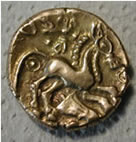
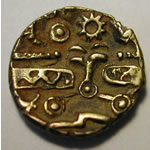
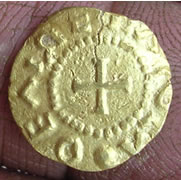
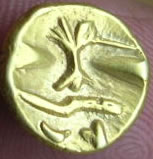
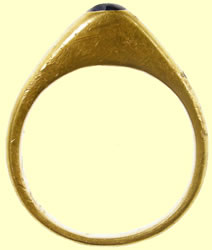
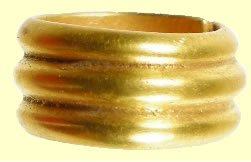
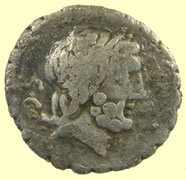
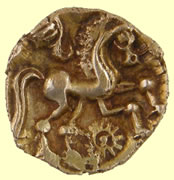
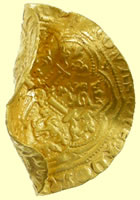
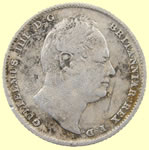


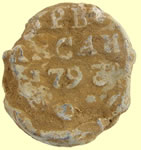
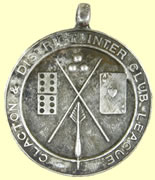


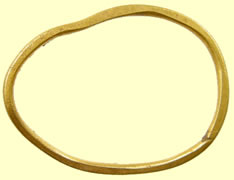
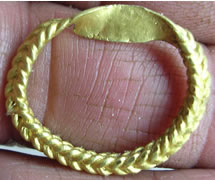
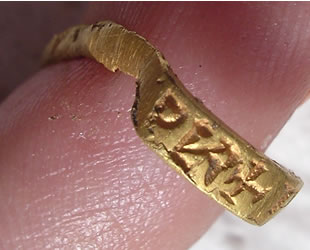





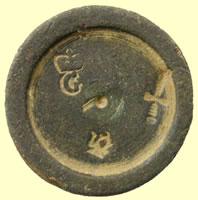
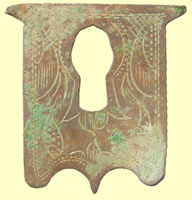





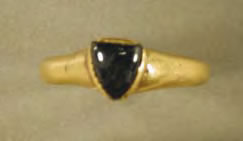
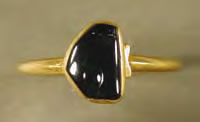

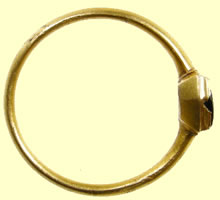
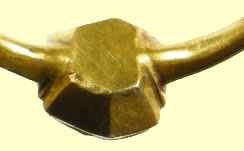
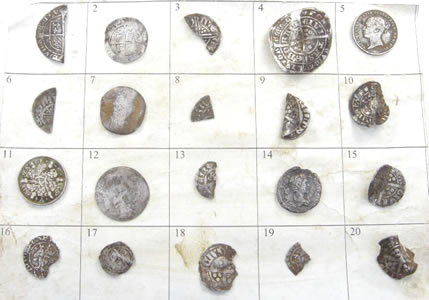
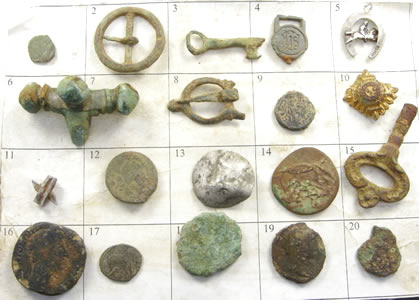
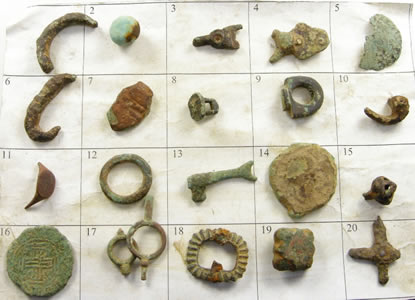
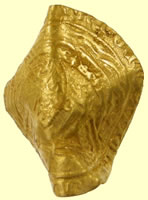

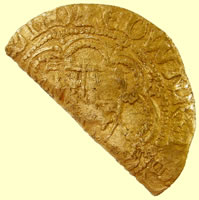
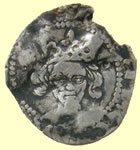
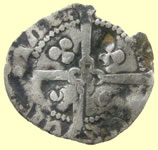
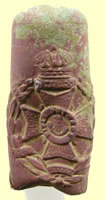
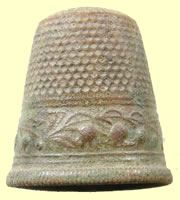
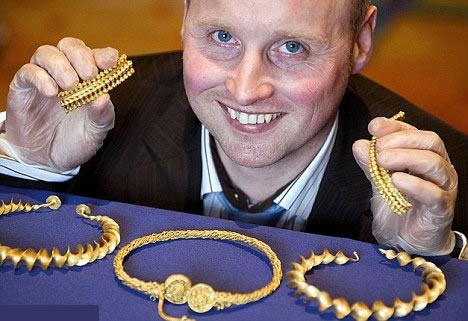
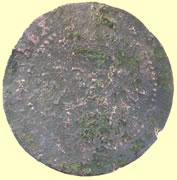
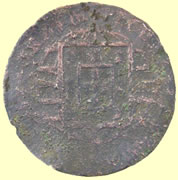
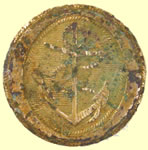

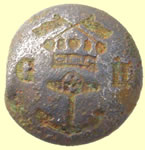
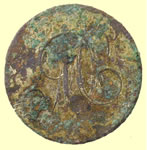
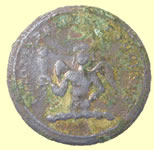

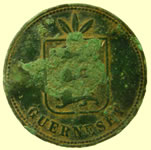
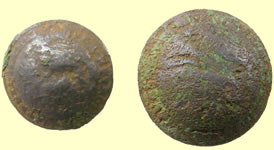
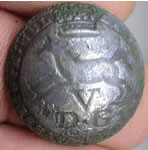


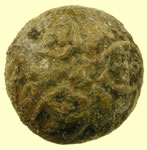
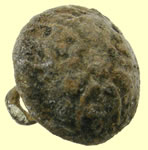
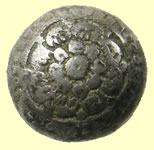
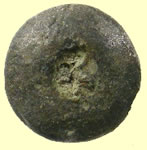


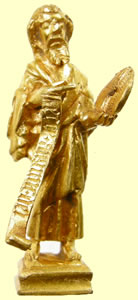
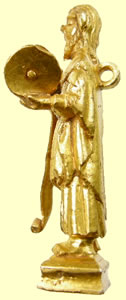
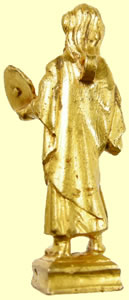

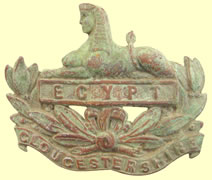
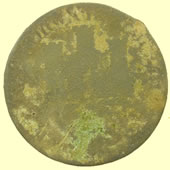
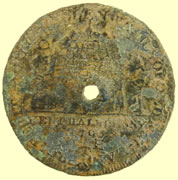
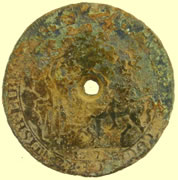
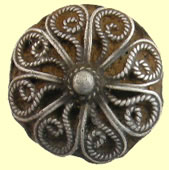
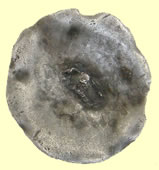

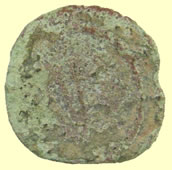


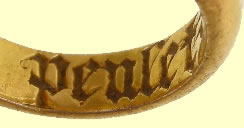

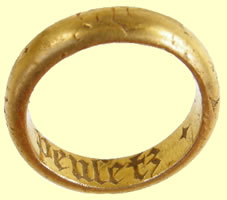

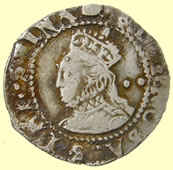
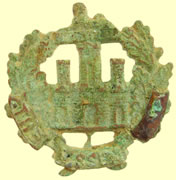
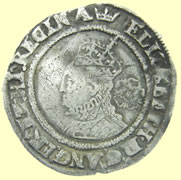
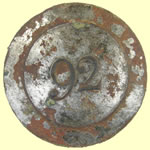
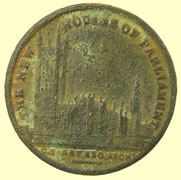



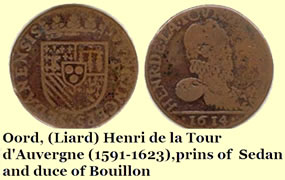
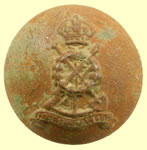

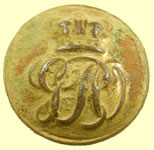
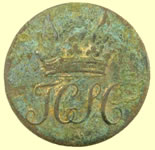

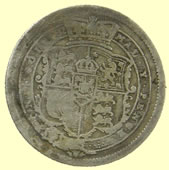


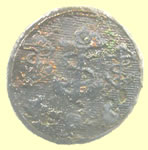
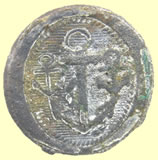
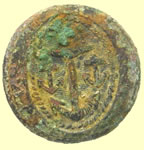

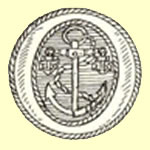






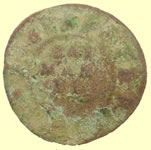

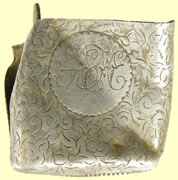
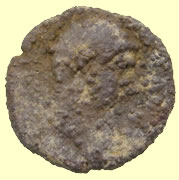
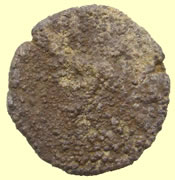
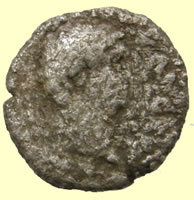
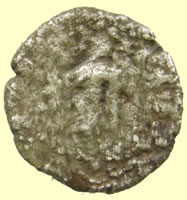
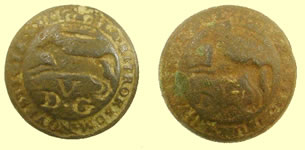
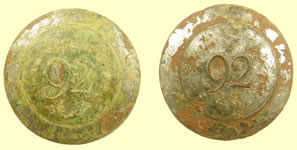
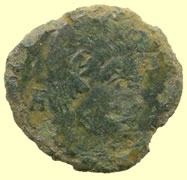
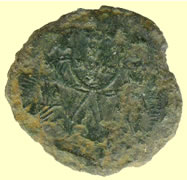
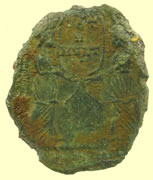
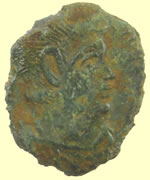

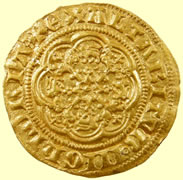
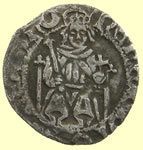

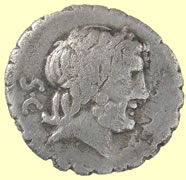
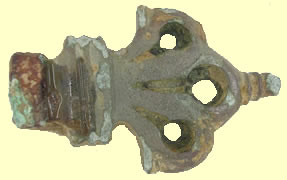
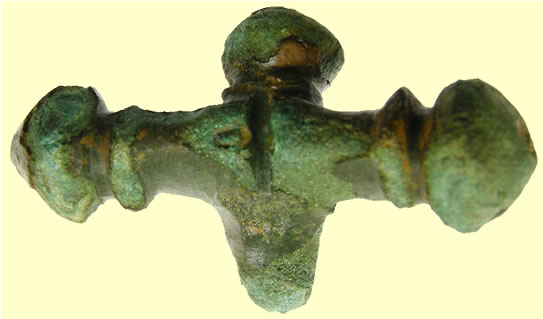
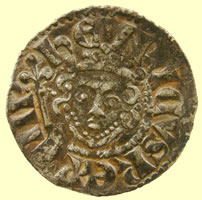
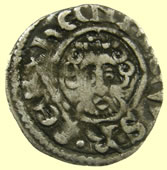

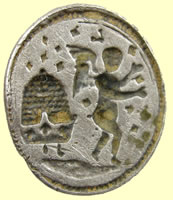
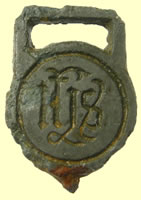



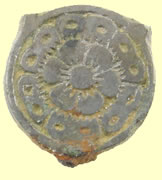
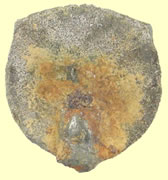
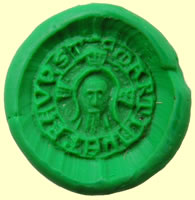
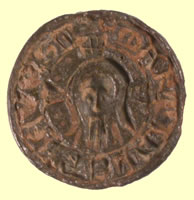
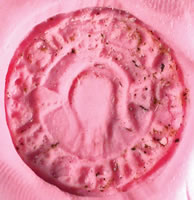
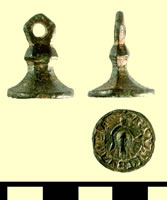

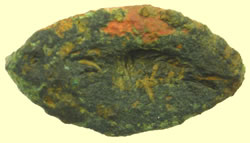
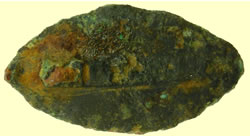

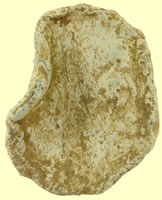
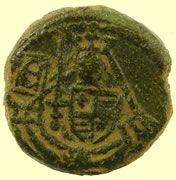
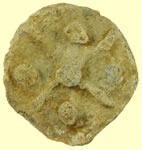
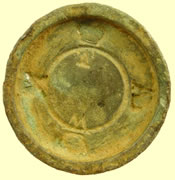
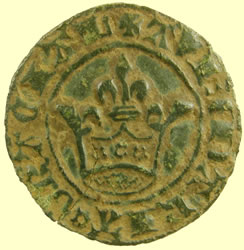


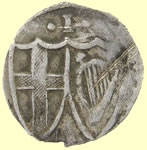

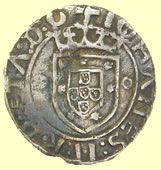
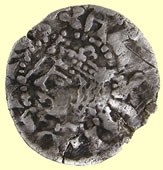

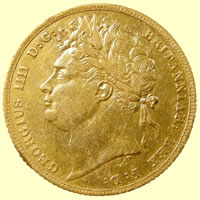

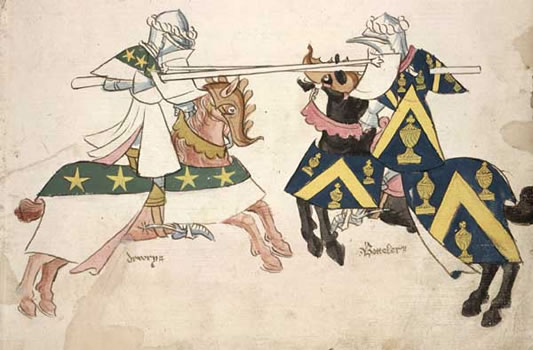

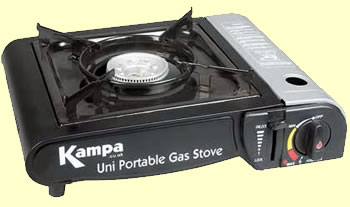
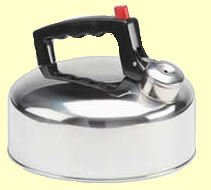


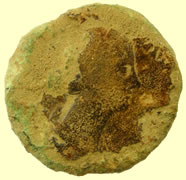
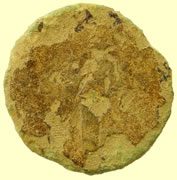
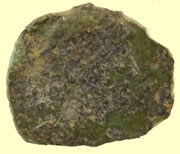
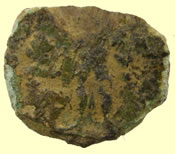
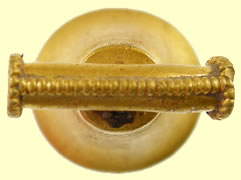
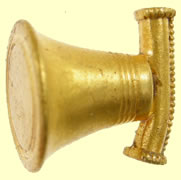




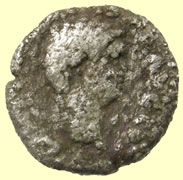
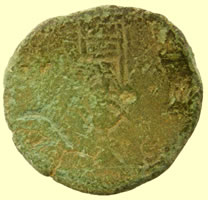
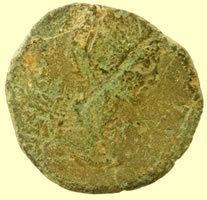
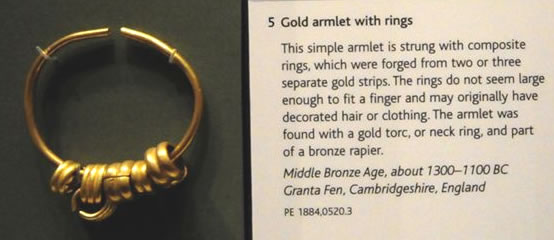
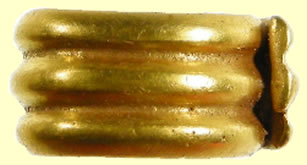
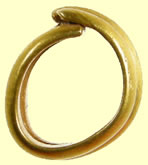
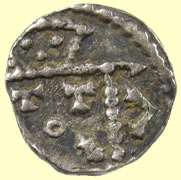

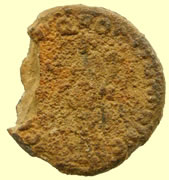
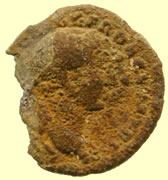

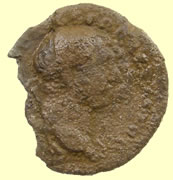

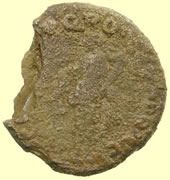

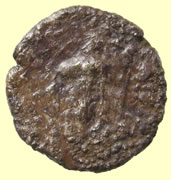
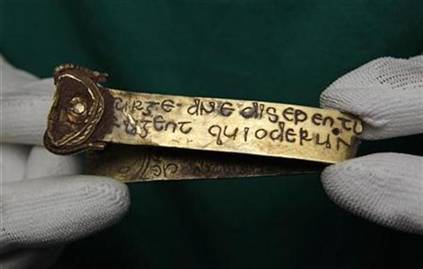



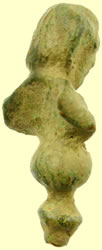



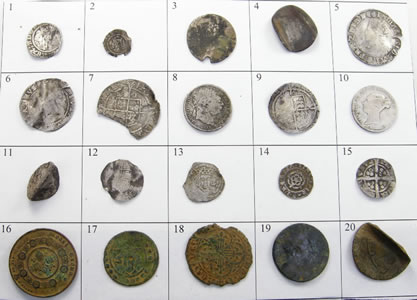
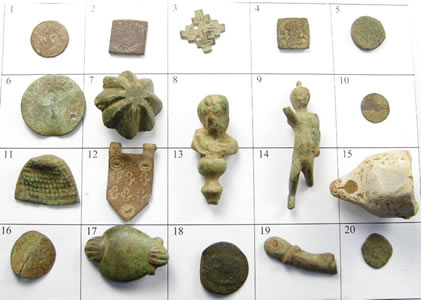
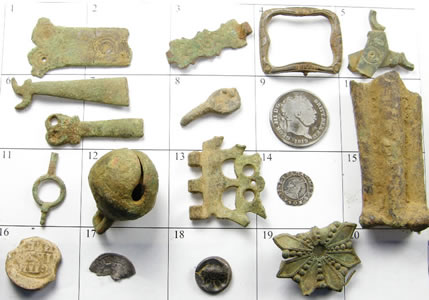

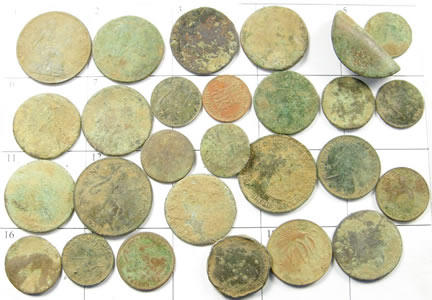
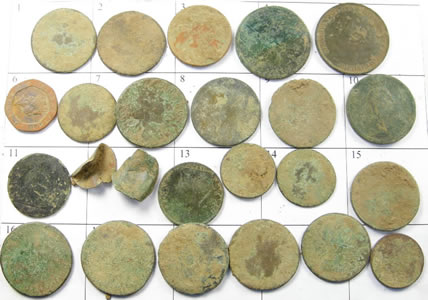
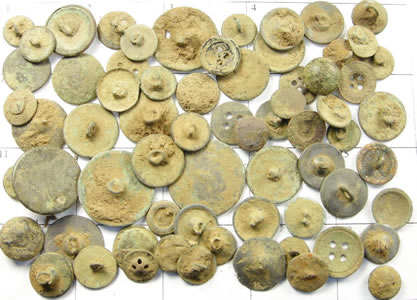
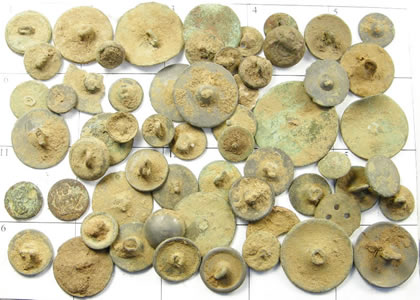
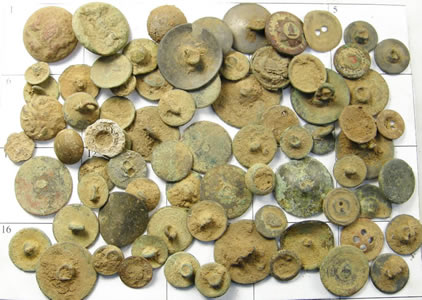
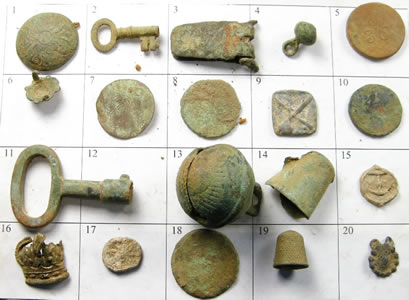
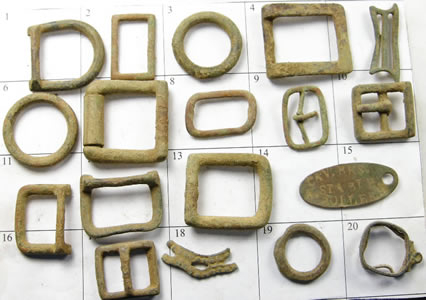
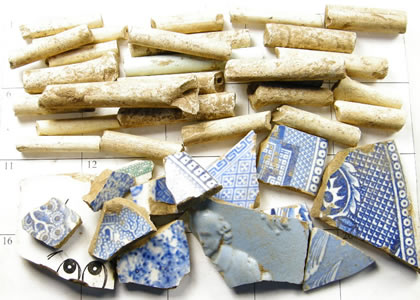
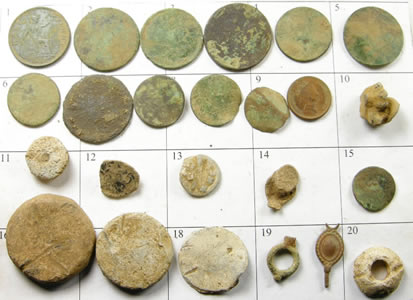

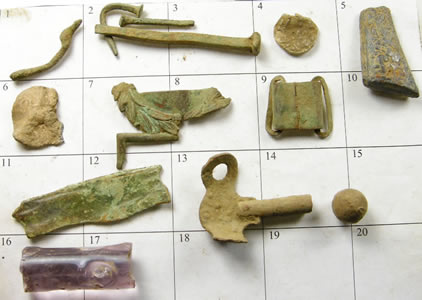
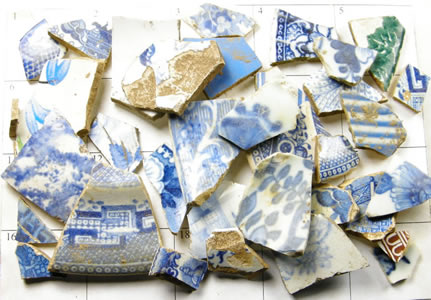
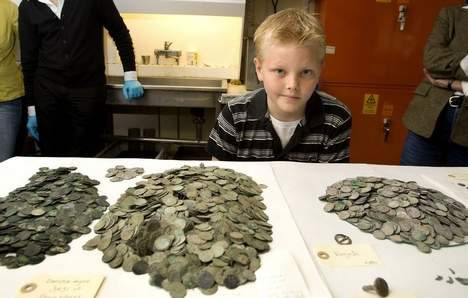
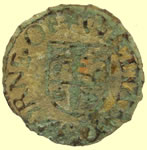
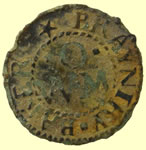
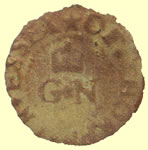
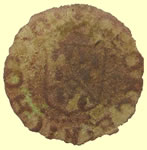
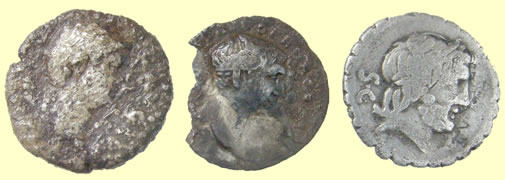
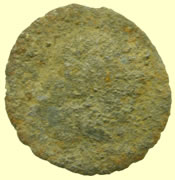
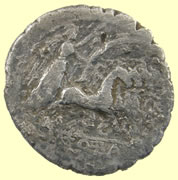

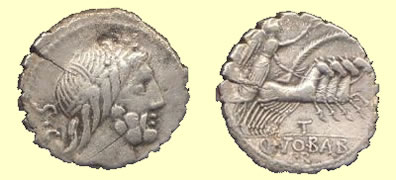

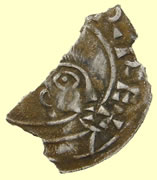
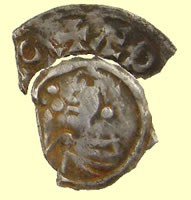
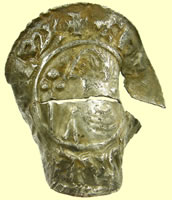
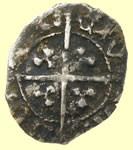

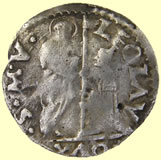
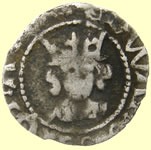
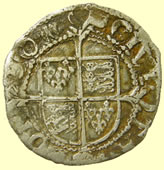
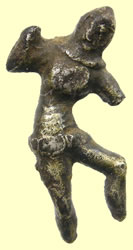
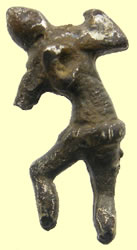

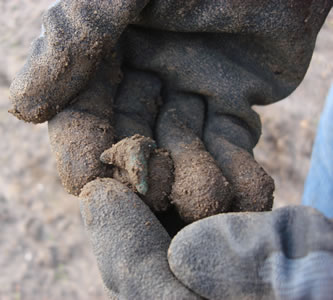
.jpg)
.jpg)
.jpg)
.jpg)
